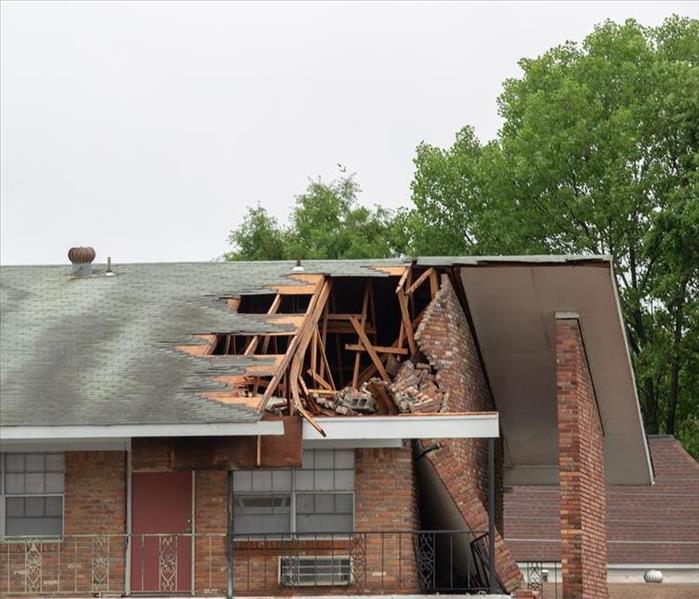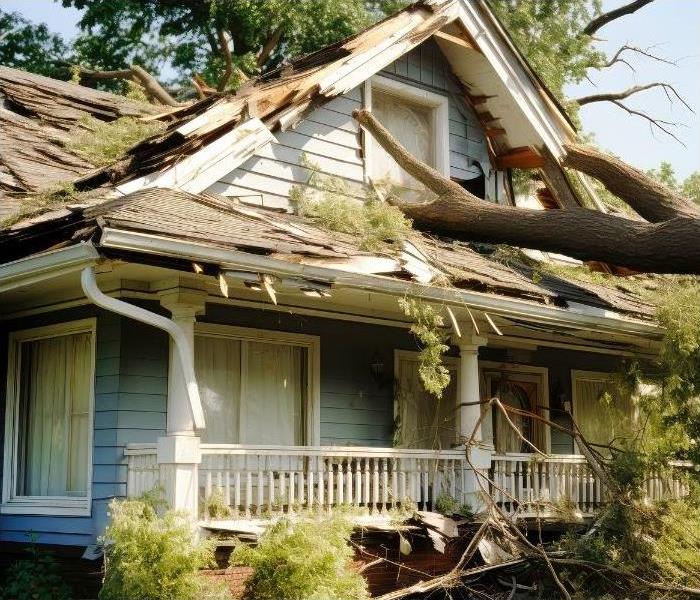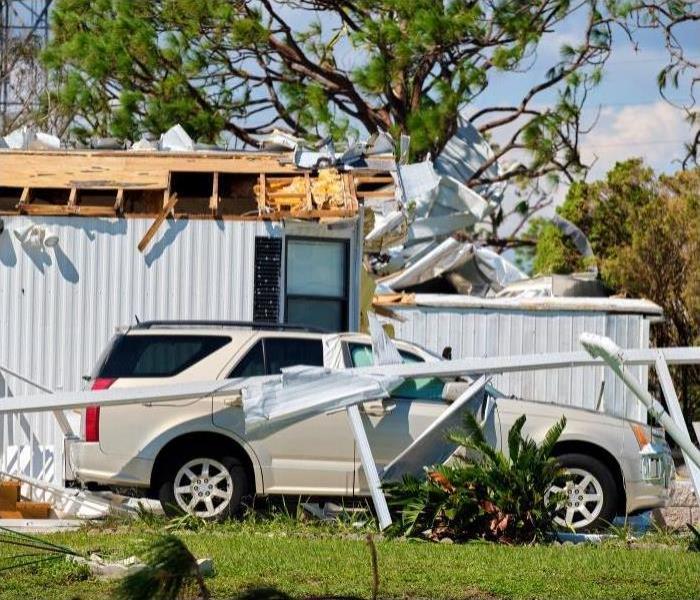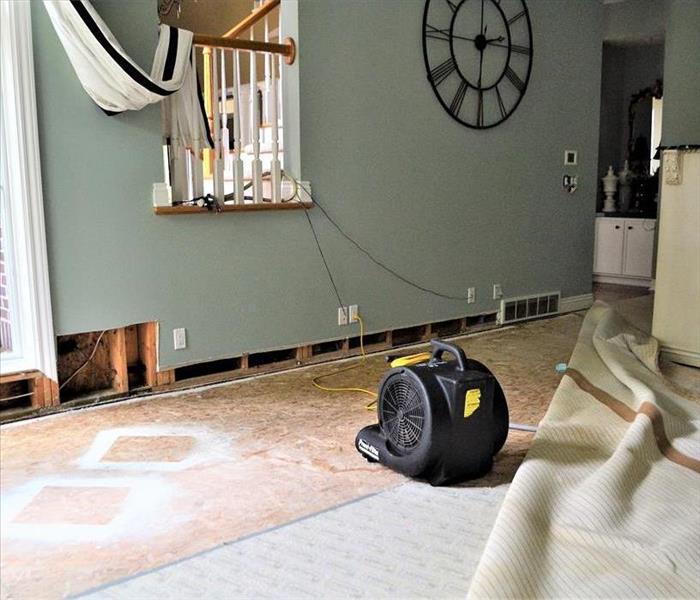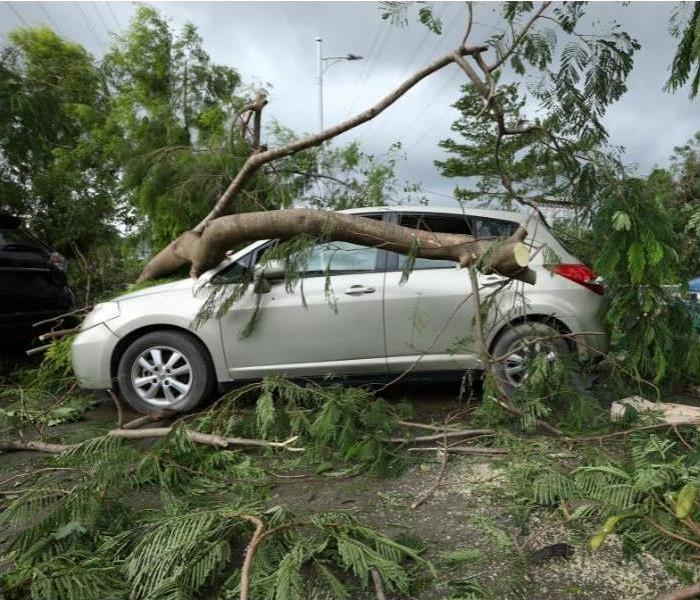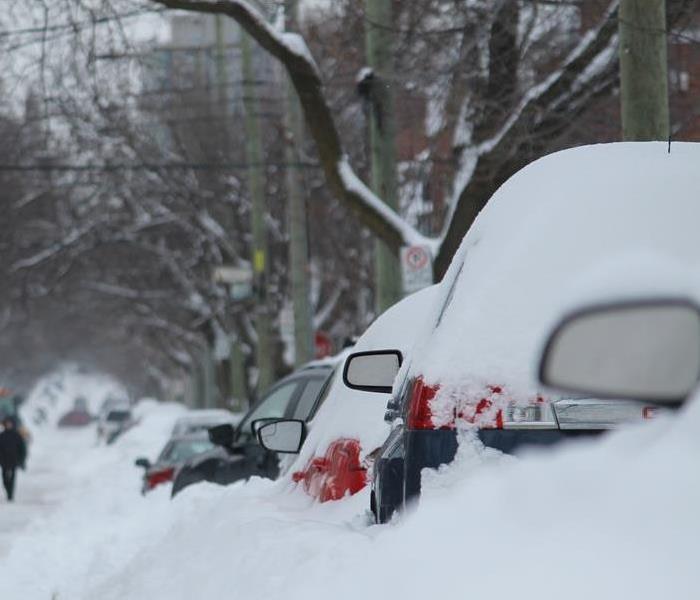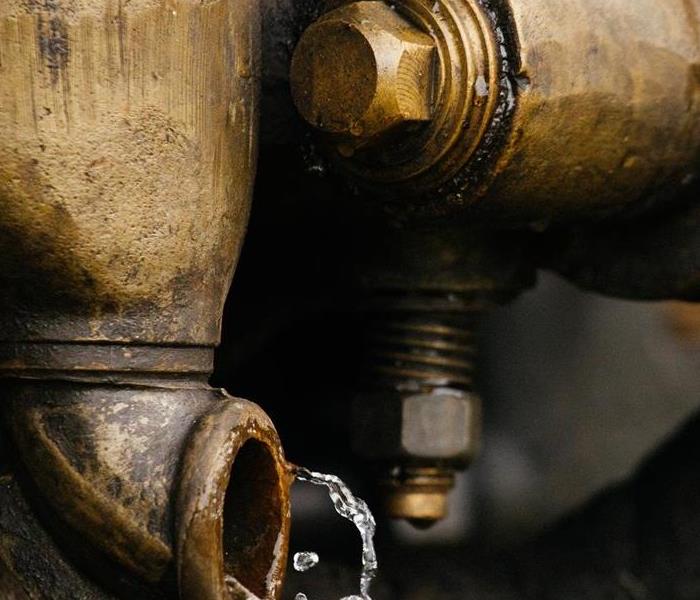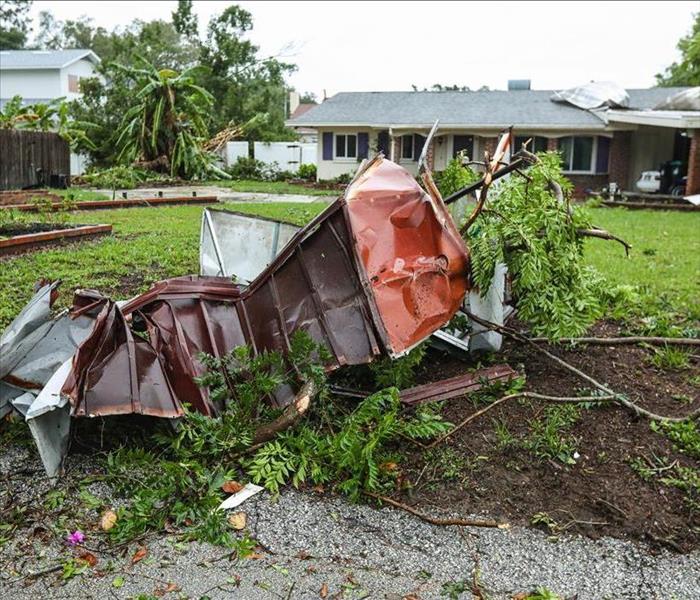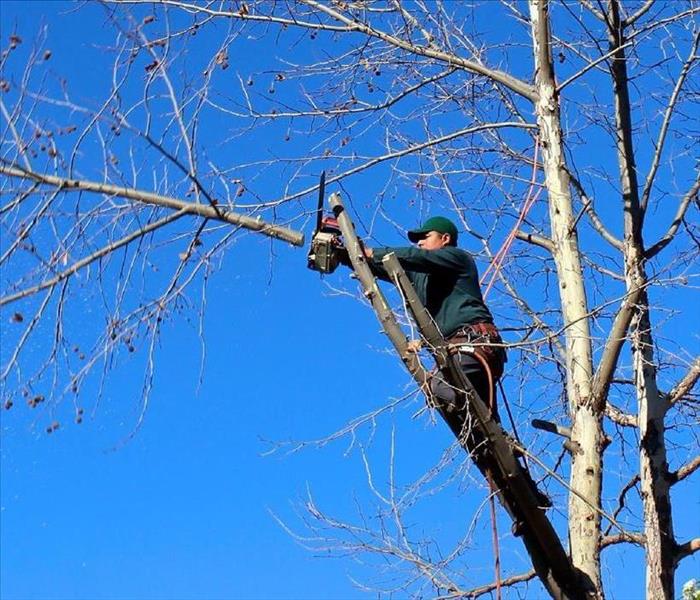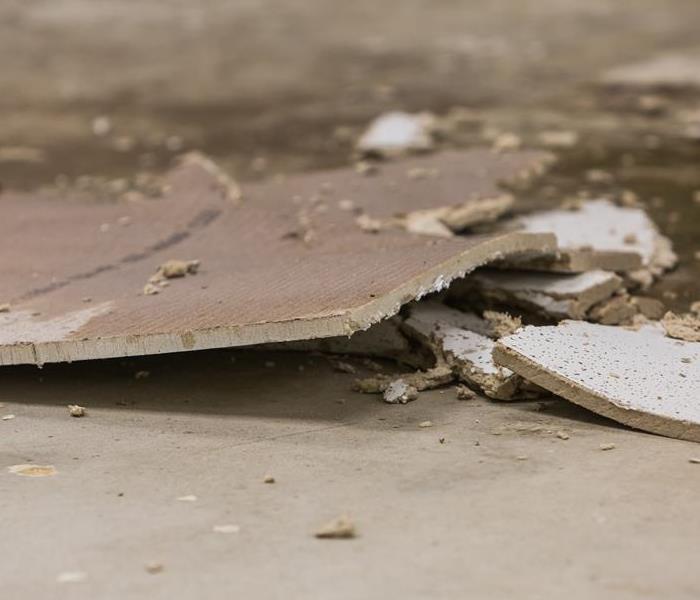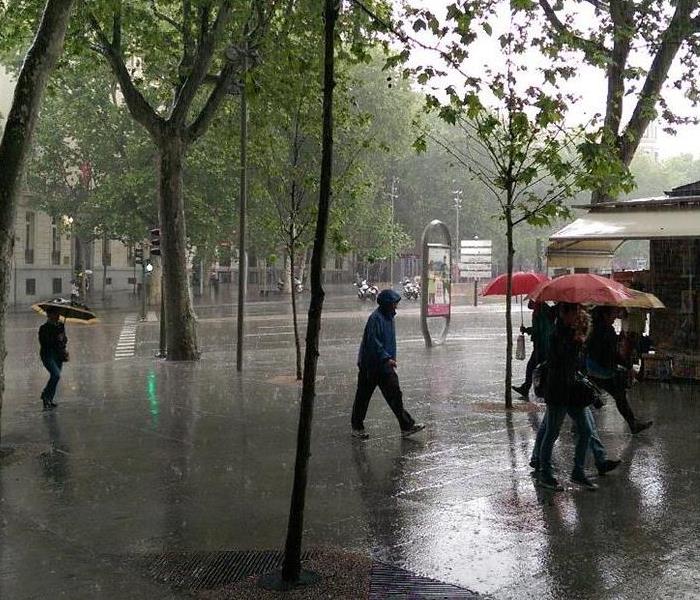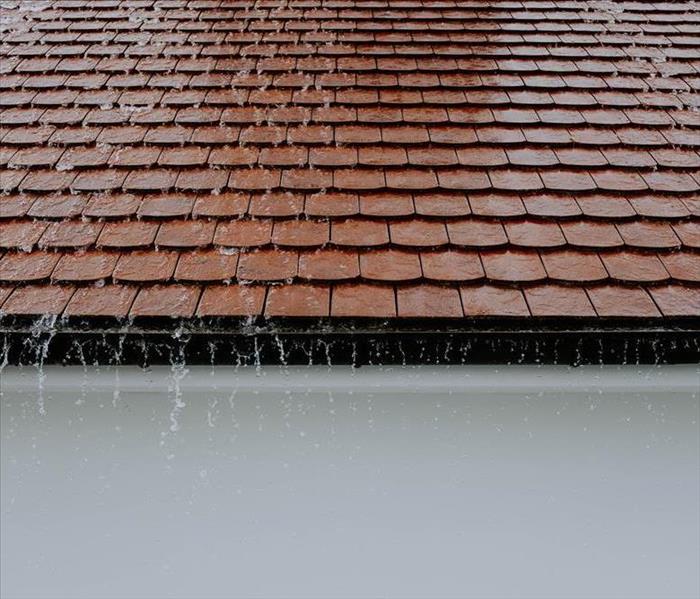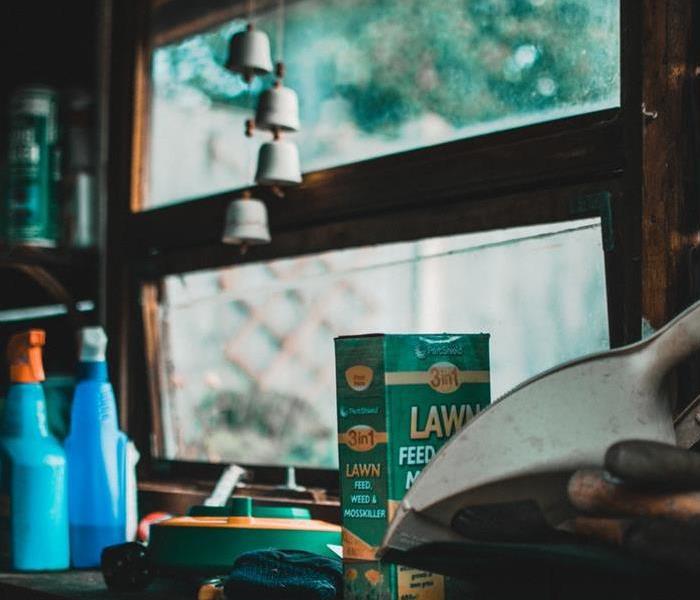Recent Storm Damage Posts
Why Prioritize Storm Damage Repair for Businesses?
7/3/2024 (Permalink)
Prioritize storm damage repair for businesses to keep operations running smoothly, prevent losses, and minimize disruptions. Timely repairs impact damage extent and customer satisfaction. Swift action avoids revenue loss and guarantees business continuity. Addressing property damage promptly prevents further issues like mold growth and structural hazards. It safeguards your business reputation and compliance with safety standards. Each aspect is essential for successful operations and customer trust. Learn more about why storm damage repair is pivotal for your business.
Key Takeaways
- Timely repairs minimize downtime and revenue loss.
- Addressing storm damage promptly reduces damage extent.
- Prevent further property damage by securing structures.
- Ensure business continuity with a solid continuity plan.
- Compliance with safety regulations protects all stakeholders.
The Importance of Timely Repairs
Making timely repairs after a storm is essential for businesses to minimize downtime and guarantee operations can resume smoothly. Preventing delays in addressing storm damage is fundamental to minimizing losses and ensuring the continuity of your business. When a storm hits, acting promptly can make a significant difference in the extent of the damage sustained.
By swiftly addressing repairs, you can prevent delays in getting your business back up and running. Downtime can result in a loss of revenue, customer dissatisfaction, and potential long-term impacts on your business's reputation. To avoid these consequences, it's important to prioritize storm damage repair to minimize disruptions to your operations.
Timely repairs also help in minimizing losses by addressing issues before they escalate. Ignoring storm damage can lead to more significant problems down the line, potentially costing your business more in repairs or even causing safety hazards for your employees and customers. Taking proactive measures to fix storm damage promptly can save you both time and money in the long run.
Avoiding Further Property Damage
To prevent worsening damage to your property post-storm, swift action to address any existing issues is essential. Failing to promptly repair storm damage can lead to further deterioration, potentially resulting in increased repair costs and prolonged business disruptions. By taking proactive steps to mitigate the impact of the storm, you can protect your property and minimize financial losses.
- Promptly address water infiltration: Water intrusion can lead to mold growth and structural damage if left unchecked. By promptly drying out affected areas and repairing any leaks, you can prevent mold from spreading and causing additional harm to your property.
- Inspect and repair roof damage: A compromised roof can allow water to seep into your building, leading to water damage and mold growth. Inspecting your roof for any signs of damage and repairing it promptly can help prevent further issues.
- Secure windows and doors: Damaged windows and doors can allow water and debris to enter your building, increasing the risk of further property damage. Securing or replacing these elements can help prevent additional storm-related issues.
- Clear debris and evaluate structural integrity: Removing debris from your property and evaluating its structural integrity can help identify potential hazards and prevent further damage. Addressing any structural issues promptly can safeguard your property and minimize the risk of additional losses.
Taking these proactive measures can help you avoid further property damage, prevent mold growth, and minimize financial losses in the aftermath of a storm.
Ensuring Business Continuity
To guarantee the continuity of your business operations following a storm, implementing a thorough continuity plan is essential. Storms can disrupt your business, leading to revenue losses and potential long-term impacts on your company's reputation. By focusing on risk management and preparing for potential storm damage, you can minimize the impact on your business operations.
One key aspect of ensuring business continuity is to have a thorough risk management strategy in place. This involves evaluating the potential risks that storms pose to your business and taking proactive measures to mitigate these risks. By identifying vulnerable areas in your operations and implementing strategies to address them, you can minimize the impact of storms on your business.
In addition to risk management, having a solid continuity plan is vital. This plan should outline how your business will continue to operate in the event of a storm, ensuring that essential functions can still be carried out even amidst disruptions. By having clear procedures and protocols in place, you can minimize downtime and reduce revenue losses.
Ultimately, by focusing on risk management and implementing a robust continuity plan, you can make sure that your business is better prepared to weather the storm and continue operating successfully even in the face of adversity.
Protecting Business Reputation
In safeguarding your business reputation, it's imperative to proactively manage how your company is perceived, especially in the aftermath of a storm. Maintaining credibility and customer trust should be at the forefront of your post-storm recovery efforts.
Here are four essential strategies to help you protect your business reputation:
- Transparent Communication: Keep your customers informed about the impact of the storm on your operations and the steps you're taking to rectify any issues. Transparency builds trust and shows your commitment to honesty.
- Quality Service Recovery: Prioritize restoring your services promptly and efficiently. By demonstrating your dedication to resolving problems caused by the storm, you reinforce your reliability and customer focus.
- Engage with Customers: Actively engage with your customers through social media, emails, or other communication channels to address their concerns and provide updates. This engagement shows that you value their feedback and are working to meet their needs.
- Show Empathy and Understanding: Acknowledge the challenges your customers may be facing due to the storm. Expressing empathy and understanding can strengthen your relationship with customers, showcasing your human side and fostering loyalty.
Compliance With Safety Regulations
Adhere to safety regulations to guarantee the well-being of your employees and customers during storm damage repair efforts. Ensuring workplace safety standards isn't just an essential aspect of running a successful business but a vital one. By prioritizing compliance with safety regulations, you demonstrate your commitment to creating a secure environment for everyone involved.
When it comes to storm damage repair, the urgency of the situation can sometimes lead to oversight in safety protocols. However, by adhering to safety regulations, you not only prevent potential accidents and injuries but also showcase your professionalism and dedication to upholding the highest standards.
Maintaining a safe workplace during repair efforts not only protects your employees and customers but also safeguards your business from potential liabilities and reputational damage. Compliance with safety regulations is a proactive approach that minimizes risks and fosters a culture of safety within your organization.
Summary
Giving high priority to storm damage repair for businesses is vital for minimizing further damage, ensuring business continuity, safeguarding reputation, and complying with safety regulations.
Timely repairs can ultimately save you time, money, and stress in the long run. Don't wait until it's too late - take action now to safeguard your business and keep operations running smoothly.
Common Storm Damage Restoration Mistakes to Avoid
6/5/2024 (Permalink)
 Common Storm Damage Restoration Mistakes to Avoid
Common Storm Damage Restoration Mistakes to Avoid
When a storm strikes, it can feel like a whirlwind of chaos, leaving destruction in its wake. But as you pick up the pieces and begin the restoration process, it's important to tread carefully.
There are common storm damage restoration mistakes that can easily be made, mistakes that can turn a difficult situation into an even bigger nightmare.
So, before you dive headfirst into the restoration process, take a moment to consider these potential pitfalls.
Ignoring the Extent of the Damage
Don't make the mistake of underestimating the true extent of storm damage to your property. It's easy to overlook the severity of the damage, especially when you're dealing with the aftermath of a chaotic storm. However, disregarding the true extent of the damage can lead to costly consequences and even pose risks to your safety.
One common mistake homeowners make is underestimating the repair costs. Storm damage can be deceiving, and what may seem like minor damage at first glance could actually be more extensive than you think. It's essential to have a professional assess the damage and provide you with an accurate estimate of the repair costs. By underestimating the costs, you may find yourself facing unexpected expenses down the road, which can strain your finances and delay the restoration process.
Another mistake to avoid is disregarding safety precautions. When storm damage occurs, it's crucial to prioritize safety above all else. Don't attempt to handle repairs on your own without the proper knowledge and equipment. Falling debris, weakened structures, or electrical hazards can pose significant risks to your well-being. Instead, hire trained professionals who can safely assess and repair the damage.
Hiring Inexperienced Restoration Contractors
One crucial factor to consider is the experience level of the restoration contractors you hire. When it comes to storm damage restoration, hiring inexperienced contractors can lead to a range of problems. Firstly, their shoddy workmanship may result in subpar repairs and further damage to your property. Inexperienced contractors may not possess the necessary skills and knowledge to accurately assess the extent of the damage or perform the required repairs. This can lead to improper restoration techniques that don't address the underlying issues, leaving your home vulnerable to future damage.
Moreover, inexperienced restoration contractors may lack the proper equipment needed to effectively and efficiently restore your property. Without the right tools, the restoration process can be delayed, leading to prolonged disruption and inconvenience for you and your family. Additionally, inadequate equipment can compromise the quality of the repairs, resulting in a less-than-satisfactory outcome.
To avoid these pitfalls, it's essential to thoroughly research and vet potential restoration contractors. Look for contractors with a proven track record of successfully handling storm damage restoration projects. Check their qualifications, certifications, and licenses to ensure they have the necessary expertise and training. Ask for references and read reviews from previous clients to gauge their level of customer satisfaction.
Delaying the Restoration Process
To ensure a timely and effective restoration process, it's crucial to promptly address any storm damage without unnecessary delays. When it comes to storm damage, time is of the essence. Acting promptly is important because it allows you to prevent further damage to your property and minimize the potential consequences of delay.
When you delay the restoration process, you're putting your property at risk. Storm damage, if left untreated, can worsen over time. Water damage can lead to mold growth and structural issues, while wind damage can compromise the integrity of your home. Delaying the restoration process gives these problems more time to develop and become more severe.
Not only does delaying the restoration process increase the risk of further damage, but it also prolongs the disruption to your life. Living in a damaged home can be stressful and uncomfortable. Delaying the restoration process means prolonging the time it takes to return to a sense of normalcy.
Additionally, delaying the restoration process can have financial implications. The longer you wait, the more extensive the damage can become and the more it will cost to repair. By acting promptly, you can potentially save yourself from higher repair costs in the long run.
Neglecting to Document the Damage
Failing to document the damage promptly can lead to complications in the storm damage restoration process. When you neglect to document the damage, you risk encountering difficulties during the damage assessment and insurance claims.
It's crucial to capture the extent of the damage accurately to ensure a smooth restoration process. Here are three reasons why neglecting to document the damage can be problematic:
- Inaccurate damage assessment: Without proper documentation, it becomes challenging to assess the full extent of the damage caused by the storm. This can result in underestimating the damage, leading to incomplete restoration efforts. Additionally, an inaccurate assessment can affect the insurance claims process, potentially resulting in insufficient coverage for the repairs.
- Delayed insurance claims: Insurance companies rely on documented evidence to process claims efficiently. When you fail to document the damage promptly, it can delay the insurance claims process. This delay can cause frustration and prolong the restoration timeline, leaving your property vulnerable to further damage.
- Disputes with insurance companies: Without proper documentation, insurance companies may dispute the validity of your claim. They may argue that the damage isn't related to the storm or that it existed prior to the incident. By neglecting to document the damage, you give the insurance company an opportunity to question the legitimacy of your claim, potentially leading to a denial or reduced coverage.
To avoid these complications, make sure to document the damage promptly and thoroughly. Take photographs and videos of the affected areas, capturing both the visible and hidden damage. Keep a detailed record of any personal belongings that have been damaged.
Overlooking Hidden Structural Issues
Be careful not to overlook any hidden structural issues during the storm damage restoration process. While it's essential to address visible damage, such as broken windows or roof leaks, it's equally important to conduct thorough structural inspections to identify any underlying issues that may have been caused by the storm. Ignoring these hidden problems can lead to more significant and costly damages in the long run.
One common hidden structural issue that often goes unnoticed is foundation damage. Storms, particularly those with high winds or heavy rainfall, can cause significant stress on a building's foundation. This can result in cracks or shifts in the foundation, compromising the structural integrity of the entire building. If left unaddressed, foundation damage can lead to further structural issues, including uneven floors, sticking doors or windows, and even collapse in extreme cases.
To avoid overlooking hidden structural issues, it's crucial to enlist the help of professionals who specialize in storm damage restoration. These experts have the knowledge and experience to conduct comprehensive structural inspections and identify any underlying problems that may not be immediately apparent. They can assess the foundation for any signs of damage and recommend appropriate repairs or reinforcements to ensure the structural stability of the building.
Final Thoughts
So, remember, don't make these common mistakes when it comes to storm damage restoration.
Take the time to assess the full extent of the damage, hire experienced professionals, and don't delay the restoration process.
And most importantly, don't forget to document all the damage.
By avoiding these mistakes, you'll be able to restore your property efficiently and effectively, ensuring you don't overlook any hidden structural issues that could cause further damage down the line.
Why Hire Professional Storm Damage Restoration Contractors?
5/20/2024 (Permalink)
 A tree falling on a house.
A tree falling on a house.
When facing storm damage, hiring professional restoration contractors is essential. You benefit from their expert skills, quick emergency response, specialized equipment, insurance knowledge, and safe restoration methods. They bring high expertise, prompt assistance, proper tools, insurance claim proficiency, and guarantee safety. Want to discover more about the advantages of working with professional storm damage restoration contractors?
Key Takeaways
- Expertise in industry standards and specialized training ensures accurate damage assessment.
- Quick response time minimizes damage with emergency preparedness and immediate dispatch protocols.
- Proper equipment and advanced technology ensure efficient and precise restoration results.
- Knowledge of insurance processes maximizes reimbursement and handles claims professionally.
- Safe restoration is ensured through industry-approved techniques, proper equipment use, and thorough damage assessment.
Expertise in Storm Damage Restoration
When hiring professional storm damage restoration contractors, make sure they possess a high level of expertise in handling the intricate challenges of restoring properties after a storm. These experts should be well-versed in industry standards to guarantee that your property is restored to its pre-storm condition efficiently and effectively. Look for contractors who've undergone specialized training in storm damage restoration, as this will equip them with the necessary skills and knowledge to tackle the complexities that may arise during the restoration process.
Professional contractors who adhere to industry standards are better equipped to assess the extent of the damage accurately and develop a thorough restoration plan tailored to your specific needs. Their specialized training enables them to employ advanced techniques and technologies that are essential for restoring properties damaged by storms. By entrusting your property to experts with the right expertise, you can have peace of mind knowing that the restoration process will be carried out professionally and in line with the highest industry standards.
In the storm damage restoration industry, specialized training plays a significant role in ensuring that contractors can deliver exceptional results in restoring properties. By choosing contractors with expertise in industry standards and specialized training, you're making a wise investment in the future of your property's restoration.
Quick Response Time for Emergencies
In emergency situations, a prompt response time from storm damage restoration contractors is essential to mitigate further property damage and guarantee a swift restoration process. When facing the aftermath of a storm, timely assistance is critical in preventing additional issues such as water damage, mold growth, or structural deterioration. Professional contractors focusing on emergency preparedness understand the situation's urgency and are equipped to act swiftly.
Storm damage restoration contractors who prioritize quick response times have protocols in place to make sure they can be on-site promptly. They've systems that allow for immediate dispatch upon receiving your call for help. This rapid reaction is key in containing the damage and starting the restoration process without delay.
Proper Equipment and Tools
Proper equipment and tools play a pivotal role in the effective and efficient restoration of storm-damaged properties. When hiring professional storm damage restoration contractors, it's important to make sure they've access to the necessary resources. Here's why:
- Advanced Technology: Utilizing cutting-edge equipment such as moisture meters, infrared cameras, and industrial-grade dehumidifiers allows contractors to accurately assess the extent of damage and implement targeted restoration efforts promptly.
- Specialized Training: Contractors with specialized training in handling advanced restoration equipment can efficiently mitigate storm damage. This expertise ensures that the restoration process is conducted effectively, preventing further issues like mold growth or structural damage.
- Efficiency and Precision: Equipped with the right tools and technology, professionals can work swiftly and with precision. This not only speeds up the restoration process but also ensures that every step is carried out meticulously, providing high-quality results.
- Safety and Compliance: Professional contractors are well-versed in safety protocols and industry standards. They use specialized tools that not only aid in restoration but also guarantee the safety of both the property and its occupants. Compliance with regulations is important in delivering a secure and reliable restoration service.
Knowledge of Insurance Processes
Having the knowledge of insurance processes is essential for professional storm damage restoration contractors to effectively navigate and assist clients through the claims and reimbursement procedures. Understanding insurance claims is vital in ensuring that the restoration process is smooth and that clients receive the coverage they're entitled to. Professional contractors are well-versed in the documentation process required by insurance companies. They can help you gather the necessary evidence, fill out paperwork correctly, and submit claims promptly.
Insurance claims can often be intricate and confusing, but with a contractor who understands the ins and outs of the process, you can have peace of mind knowing that your claim is being handled professionally. These experts can also help negotiate with the insurance company on your behalf to maximize your reimbursement. By entrusting the insurance process to skilled contractors, you can focus on other important matters while they work diligently to secure the compensation you deserve.
In times of distress after a storm, having a contractor who's knowledgeable about insurance processes can provide a sense of security and relief. Their expertise in handling insurance claims and the documentation process can make the restoration journey less challenging and more manageable for you.
Ensuring Safe and Effective Restoration
To guarantee a safe and effective restoration process, prioritize conducting a thorough assessment of the storm damage to determine the extent of repairs needed. This initial step is important in ensuring that all safety precautions are taken and that the restoration techniques employed will address the damage adequately. Here are some key points to keep in mind for ensuring safe and effective restoration:
- Safety Precautions: Before beginning any restoration work, make sure that the area is safe for both workers and inhabitants. This may involve turning off electricity in the affected areas, checking for structural damage that could pose a risk, and wearing appropriate safety gear throughout the restoration process.
- Thorough Assessment: Conduct a detailed evaluation of the damage, including hidden water damage, structural issues, and potential mold growth. This will help in creating a full restoration plan tailored to your specific needs.
- Utilize Proper Equipment: Ensure that the restoration team uses the right tools and equipment for the job. This includes dehumidifiers, industrial fans, moisture meters, and protective gear.
- Follow Restoration Techniques: Implement industry-approved restoration techniques to make sure that the damage is effectively addressed and that the risk of future issues such as mold growth is minimized.
Review
Hiring professional storm damage restoration contractors is crucial for a swift and efficient recovery process. Their expertise, prompt response time, appropriate equipment, understanding of insurance processes, and dedication to safety guarantee that your property is restored to its pre-storm condition in a timely manner.
Don't hesitate to contact experienced professionals to manage the restoration process effectively and carefully.
Emergency Preparedness: How to Protect Your Home From Storm Damage
3/31/2024 (Permalink)
Are you tired of feeling like a fish out of water when protecting your home from storm damage? Well, fear not because we've got you covered.
In this discussion, we will discuss the essential steps you need to take to safeguard your home against Mother Nature's wrath. From storm-proofing your windows and doors to developing an evacuation plan, we will provide you with the knowledge and tools necessary to weather any storm that comes your way.
So, let's not waste any more time and jump right in, shall we?
Storm-Proofing Your Windows and Doors
To protect your home from storm damage, you must take steps to storm-proof your windows and doors. Sealing vulnerabilities is crucial in ensuring that your home remains safe during extreme weather conditions.
Start by inspecting your windows and doors for any cracks or gaps that could allow water, wind, or debris to enter your home. Use weatherstripping or caulk to seal these openings, ensuring a tight and secure fit.
In addition to sealing vulnerabilities, consider upgrading your windows and doors with impact resistant glass options. These specially designed windows and doors are built to withstand the force of strong winds and flying debris. They're made with multiple layers of glass, bonded together with a strong interlayer, which helps to prevent shattering upon impact.
By installing impact-resistant windows and doors, you can significantly reduce the risk of damage to your home during storms. When choosing impact-resistant glass options, look for products that meet industry standards for hurricane protection. These products are rigorously tested to ensure their resistance to wind-borne debris and high-speed winds. They're labeled with a certification that indicates their level of impact resistance.
By selecting certified products, you can have peace of mind knowing that your windows and doors are built to withstand the toughest storms. Storm-proofing your windows and doors is a crucial step in protecting your home from storm damage. By sealing vulnerabilities and investing in impact-resistant glass options, you can create a secure and resilient barrier against extreme weather conditions.
Securing Outdoor Furniture and Objects
Secure your outdoor furniture and objects to prevent them from becoming dangerous projectiles during a storm. When strong winds and heavy rain hit, unsecured items can easily get picked up and thrown around, causing damage to your property and posing a threat to your safety. To protect your belongings and ensure a sense of belonging in your outdoor space, taking the necessary precautions and properly securing everything in place is crucial.
One effective way to secure your outdoor furniture is by using anchoring equipment. This includes heavy-duty straps, bungee cords, or ropes that can be used to tie down larger items such as patio tables, chairs, and umbrellas. Make sure to attach the straps or cords to a secure anchor point, like a tree or a fixed structure, ensuring that they're tightly fastened to prevent any movement. Consider using stakes or weights to keep them firmly in place for smaller objects like planters or decorative items.
In addition to securing your furniture, it's important to pay attention to outdoor structures such as sheds, gazebos, or playsets. If not properly secured, these structures can easily be damaged or destroyed during a storm. Use anchoring kits specifically designed for outdoor structures to secure them to the ground. These kits typically include strong, durable anchors that are driven into the ground and attached to the structure using sturdy cables or chains.
Reinforcing Your Roof and Gutters
Reinforce your roof and gutters to protect your home from storm damage. Your roof is the first line of defense against heavy rains, strong winds, and flying debris during a storm. Conduct a thorough roof inspection before the storm season begins to identify any weak spots or areas that may need reinforcing. Look for missing or damaged shingles, loose flashing, and signs of water damage. It's also important to check the gutters and downspouts for any blockages or damage. Clear out any debris, such as leaves or branches, and make sure the gutters are securely fastened to the roof.
If you notice any issues during the roof inspection, it's crucial to address them promptly. Hire a professional roofing contractor, if needed, to ensure that the repairs or reinforcements are done correctly. Reinforcing your roof may involve replacing damaged shingles, strengthening the flashing, or adding additional support in vulnerable areas. It's a worthwhile investment that will enhance the resilience of your home during storms.
Regular gutter maintenance is equally important for protecting your home during storms. Clogged or damaged gutters can lead to water overflow, which can cause significant damage to your roof, walls, and foundation. Clean your gutters at least twice a year or more frequently if you live in an area with many trees. Remove any leaves, twigs, or debris that may be blocking the flow of water. Check for leaks or loose connections and repair them promptly.
Creating an Emergency Preparedness Kit
Before the storm season begins, it's important to make sure you're prepared by creating an emergency preparedness kit. Stocking essentials and having a plan for emergency communication are crucial for keeping yourself and your loved ones safe during a storm.
Here are three items to include in your emergency preparedness kit:
- Water and Non-perishable Food: Make sure to have an ample supply of bottled water to last at least three days. Additionally, stock up on non-perishable food items like canned goods, granola bars, and dried fruits. These will provide nourishment in case of power outages or limited access to groceries.
- First Aid Kit: It's essential to have a well-stocked first aid kit to address any injuries that may occur during a storm. Include items such as adhesive bandages, antiseptic wipes, pain relievers, and any necessary prescription medications. Also, consider adding a manual for basic first aid procedures.
- Emergency Communication Devices: During a storm, communication can become difficult. It's important to have reliable devices for emergency communication. Include a battery-powered or hand-crank radio to stay updated on weather conditions and any official announcements. Additionally, keep a fully charged mobile phone with a backup battery pack to ensure you can reach out for help if needed.
Developing an Evacuation Plan
To ensure your safety during a storm, it's important to develop an evacuation plan. Having a well-thought-out plan in place will give you peace of mind and help you stay organized in case of an emergency.
The first step in creating your evacuation plan is to identify the safest evacuation routes in your area. Take the time to familiarize yourself with these routes and map out the quickest and safest way to get to a designated shelter or a safe location.
It's also crucial to have the necessary emergency contact information readily available. Make a list of important phone numbers, such as local authorities, emergency services, and family members, and keep it in a visible and easily accessible place. In addition to phone numbers, include any special instructions or procedures provided by your local emergency management agency. Remember to update this information regularly to ensure its accuracy.
When developing your evacuation plan, involve your family or household members. Make sure everyone understands the plan and their roles during an evacuation. Assign specific tasks to each individual, such as grabbing important documents, packing essential supplies, or securing the house.
Practice your evacuation plan regularly to ensure that everyone knows what to do in case of an emergency. This will help build confidence and reduce anxiety during a real evacuation.
Wrap-Up
To ensure the safety of your home during a storm, it's crucial to take proactive measures.
Storm-proofing your windows and doors, securing outdoor furniture, reinforcing your roof and gutters, and creating an emergency preparedness kit can minimize storm damage.
Having an evacuation plan in place is essential.
Taking these steps can help protect your home and save you from costly repairs.
Storm Damage Restoration: Everything You Need to Know
3/5/2024 (Permalink)
Has your home recently been hit by a powerful storm, leaving behind a trail of destruction? Storm damage can be overwhelming, but understanding the restoration process can help ease your worries.
From assessing the extent of the damage to preventing future storms from wreaking havoc on your property, this comprehensive guide will provide you with everything you need to know about storm damage restoration.
So, let's dive in and explore the steps you can take to restore your home to its former glory.
Assessing the Damage
Now that the storm has passed, it's time for you to assess the damage. It can be overwhelming to see the aftermath of a storm, but evaluating the extent of the damage is crucial in order to start the restoration process. Take a deep breath, and let's begin.
First, walk around your property and carefully inspect all areas that have been affected by the storm. Look for any visible signs of damage, such as fallen trees, broken windows, damaged roofs, or water leaks. Make a list of all the areas that require immediate attention.
Once you have assessed the damage, it's important to contact professionals who specialize in storm damage restoration. These experts have the knowledge and experience to handle the repairs and ensure that your property is restored to its pre-storm condition. They'll be able to give you a detailed assessment of the damage and provide you with an estimate of the costs involved.
When contacting professionals, be sure to provide them with accurate information about the extent of the damage. This will help them determine the resources and equipment needed to restore your property. It's also important to ask for references and check their credentials to ensure that you're hiring reliable and trustworthy professionals.
Hiring a Storm Damage Restoration Company
Consider hiring a storm damage restoration company to restore your property efficiently and effectively. Dealing with the aftermath of a storm can be overwhelming, but with the help of professionals, you can navigate the storm damage restoration process smoothly.
Finding reputable contractors is crucial to ensure that your property is restored to its pre-storm condition. When searching for a storm damage restoration company, start by asking for recommendations from friends, family, or neighbors who've gone through similar experiences. Their firsthand experiences can provide valuable insights into the quality of work and customer service provided by different contractors. Additionally, you can also check online review platforms and local business directories to find reputable companies in your area.
Once you have a list of potential contractors, it's important to do some research to further evaluate their credibility. Look for companies that are licensed, insured, and bonded, as this ensures that they meet the necessary requirements and have the expertise to handle your restoration needs. You can also check if they're affiliated with any professional organizations, as this reflects their commitment to industry standards and continuous improvement.
When contacting potential contractors, ask for references and examples of their previous work. This will give you an idea of their capabilities and the quality of their craftsmanship. It's also beneficial to inquire about their experience with insurance claims, as navigating the claims process can be complex.
Insurance Claims and Documentation
To ensure a smooth insurance claims process, it's important to gather and document all necessary information related to the storm damage. This will help you navigate through the filing process and ensure a fair claim settlement.
Here are three key steps to help you with your insurance claims and documentation:
- Document the damage: Take photos or videos of the damage caused by the storm. Make sure to capture both the overall view and close-ups of any specific areas affected. This visual evidence will be crucial when filing your claim and can help support your case during the claim settlement process.
- Keep records of all expenses: It's important to document any expenses incurred as a result of the storm damage. This includes receipts for repairs, temporary accommodations, and any other costs related to the restoration process. These records will be necessary when filing your claim and can help ensure you're properly compensated for your losses.
- Review your insurance policy: Familiarize yourself with the details of your insurance policy, including coverage limits and deductibles. Understanding your policy will help you navigate the filing process more effectively and ensure you receive the maximum claim settlement you're entitled to.
Restoring Your Property's Structure
After documenting the storm damage and gathering all necessary information for your insurance claim, the next step is to focus on restoring your property's structure. This is an important part of the recovery process, as it ensures the safety and stability of your home, making it feel like a place where you truly belong.
One crucial aspect of restoring your property's structure is repairing the foundation. The foundation is the base upon which your home stands, providing support and stability. Storms can cause significant damage to the foundation, such as cracks or shifts. It's essential to hire a professional contractor who specializes in foundation repair to assess the damage and develop a plan for restoration. They'll use techniques like underpinning or slabjacking to stabilize and repair the foundation, ensuring the structural integrity of your home.
Another vital area to address is fixing the roof. Storms can cause extensive damage to roofs, including missing shingles, leaks, or even structural damage. A damaged roof not only compromises the safety of your home but also affects its overall appearance. It's crucial to have a qualified roofing contractor inspect the roof and make the necessary repairs. They'll replace missing shingles, repair leaks, and address any underlying structural issues. By fixing the roof, you not only prevent further damage but also restore the aesthetics and functionality of your home.
Restoring your property's structure is a significant step towards making your house feel like home again. By repairing the foundation and fixing the roof, you ensure the safety, stability, and visual appeal of your property. Remember to work with professionals who specialize in these areas to ensure high-quality restoration and a seamless recovery process.
Preventing Future Storm Damage
To protect your property from future storm damage, take proactive measures to strengthen its defenses. By implementing storm damage prevention strategies, you can ensure the safety and security of your home. Here are three key steps to help you fortify your property and minimize the risk of storm damage:
- Maintain your roof:
Your roof is your home's first line of defense against the elements. Regularly inspect it for any signs of damage, such as missing shingles or cracks. Repair or replace damaged roofing materials promptly to prevent water leaks and structural issues during storms. Consider reinforcing your roof with hurricane straps or clips for added protection. - Secure doors and windows:
Strong winds can easily breach weak points in your home's exterior. Install impact-resistant windows and doors that can withstand high winds and flying debris. Reinforce them with storm shutters or plywood covers during severe weather events. Don't forget to seal any gaps or cracks around doors and windows to prevent water intrusion. - Maintain your landscape:
Proper landscaping can help mitigate storm damage. Trim trees and remove dead branches to prevent them from falling on your home during strong winds. Clear gutters and downspouts regularly to ensure proper drainage and prevent water damage. Consider installing a French drain or a rain garden to redirect excess water away from your property.
Wrap-Up
So there you have it, folks! Now, you're equipped with everything you need to know about storm damage restoration.
Remember, when it comes to assessing the damage, hiring a reliable restoration company, and dealing with insurance claims, it's always better to be prepared.
Don't forget to restore your property's structure properly and take preventive measures for the future. After all, an ounce of prevention is worth a pound of cure, or in this case, a storm-free sanctuary!
Stay safe and storm-ready, my friends.
Storm Damage Restoration: Everything You Need to Know
1/8/2024 (Permalink)
Has your home recently been hit by a powerful storm, leaving behind a trail of destruction? Storm damage can be overwhelming, but understanding the restoration process can help ease your worries.
From assessing the extent of the damage to preventing future storms from wreaking havoc on your property, this comprehensive guide will provide you with everything you need to know about storm damage restoration.
So, let's dive in and explore the steps you can take to restore your home to its former glory.
Assessing the Damage
Now that the storm has passed, it's time for you to assess the damage. It can be overwhelming to see the aftermath of a storm, but evaluating the extent of the damage is crucial to start the restoration process. Take a deep breath, and let's begin.
First, walk around your property and carefully inspect all storm-affected areas. Look for any visible signs of damage, such as fallen trees, broken windows, damaged roofs, or water leaks. Make a list of all the areas that require immediate attention.
Once you have assessed the damage, contacting professionals specializing in storm damage restoration is important. These experts have the knowledge and experience to handle the repairs and ensure your property is restored to its pre-storm condition. They'll be able to give you a detailed assessment of the damage and provide you with an estimate of the costs involved.
When contacting professionals, be sure to provide them with accurate information about the extent of the damage. This will help them determine the resources and equipment needed to restore your property. It's also important to ask for references and check their credentials to ensure you hire reliable and trustworthy professionals.
Hiring a Storm Damage Restoration Company
Consider hiring a storm damage restoration company to restore your property efficiently and effectively. Dealing with the aftermath of a storm can be overwhelming, but with the help of professionals, you can navigate the storm damage restoration process smoothly.
Finding reputable contractors is crucial to restore your property to its pre-storm condition. When searching for a storm damage restoration company, ask for recommendations from friends, family, or neighbors who've gone through similar experiences. Their firsthand experiences can provide valuable insights into the quality of work and customer service of different contractors. You can also check online review platforms and local business directories to find reputable companies in your area.
Once you have a list of potential contractors, it's important to do some research to evaluate their credibility further. Look for licensed, insured, and bonded companies, as this ensures that they meet the necessary requirements and have the expertise to handle your restoration needs. You can also check if they're affiliated with any professional organizations, as this reflects their commitment to industry standards and continuous improvement.
When contacting potential contractors, ask for references and examples of their previous work. This will give you an idea of their capabilities and the quality of their craftsmanship. It's also beneficial to inquire about their experience with insurance claims, as navigating the claims process can be complex.
Insurance Claims and Documentation
To ensure a smooth insurance claims process, gathering and documenting all necessary information related to the storm damage is important. This will help you navigate filing and ensure a fair claim settlement.
Here are three key steps to help you with your insurance claims and documentation:
- Document the damage: Take photos or videos of the damage caused by the storm. Make sure to capture both the overall view and close-ups of any specific areas affected. This visual evidence will be crucial when filing your claim and can help support your case during the claim settlement process.
- Keep records of all expenses: It's important to document any expenses incurred due to the storm damage. This includes receipts for repairs, temporary accommodations, and any other costs related to the restoration process. These records will be necessary when filing your claim and can help ensure you're properly compensated for your losses.
- Review your insurance policy: Familiarize yourself with the details of your insurance policy, including coverage limits and deductibles. Understanding your policy will help you navigate the filing process more effectively and ensure you receive the maximum claim settlement you're entitled to.
Restoring Your Property's Structure
After documenting the storm damage and gathering all necessary information for your insurance claim, the next step is restoring your property's structure. This is an important part of the recovery process, as it ensures the safety and stability of your home, making it feel like a place where you truly belong.
One crucial aspect of restoring your property's structure is repairing the foundation. The foundation is the base upon which your home stands, providing support and stability. Storms can cause significant damage to the foundation, such as cracks or shifts. It's essential to hire a professional contractor specializing in foundation repair to assess the damage and develop a restoration plan. They'll use techniques like underpinning or slabjacking to stabilize and repair the foundation, ensuring the structural integrity of your home.
Another vital area to address is fixing the roof. Storms can cause extensive damage to roofs, including missing shingles, leaks, or even structural damage. A damaged roof not only compromises the safety of your home but also affects its overall appearance. It's crucial to have a qualified roofing contractor inspect the roof and make the necessary repairs. They'll replace missing shingles, repair leaks, and address any underlying structural issues. By fixing the roof, you not only prevent further damage but also restore the aesthetics and functionality of your home.
Restoring your property's structure is a significant step towards making your house feel like home again. By repairing the foundation and fixing the roof, you ensure your property's safety, stability, and visual appeal. Remember to work with professionals in these areas to ensure high-quality restoration and a seamless recovery process.
Preventing Future Storm Damage
To protect your property from future storm damage, take proactive measures to strengthen its defenses. By implementing storm damage prevention strategies, you can ensure the safety and security of your home. Here are three key steps to help you fortify your property and minimize the risk of storm damage:
- Maintain your roof:
Your roof is your home's first line of defense against the elements. Regularly inspect it for any signs of damage, such as missing shingles or cracks. Repair or replace damaged roofing materials promptly to prevent water leaks and structural issues during storms. Consider reinforcing your roof with hurricane straps or clips for added protection. - Secure doors and windows:
Strong winds can easily breach weak points in your home's exterior. Install impact-resistant windows and doors that can withstand high winds and flying debris. Reinforce them with storm shutters or plywood covers during severe weather events. Don't forget to seal any gaps or cracks around doors and windows to prevent water intrusion. - Maintain your landscape:
Proper landscaping can help mitigate storm damage. Trim trees and remove dead branches to prevent them from falling on your home during strong winds. Clear gutters and downspouts regularly to ensure proper drainage and prevent water damage. Consider installing a French drain or a rain garden to redirect excess water away from your property.
Review
So there you have it, folks! Now, you're equipped with everything you need to know about storm damage restoration.
Remember, when it comes to assessing the damage, hiring a reliable restoration company, and dealing with insurance claims, it's always better to be prepared.
Don't forget to restore your property's structure properly and take preventive measures for the future. After all, an ounce of prevention is worth a pound of cure, or in this case, a storm-free sanctuary!
Stay safe and storm-ready, my friends.
Property Damage Restoration: What to Expect
12/20/2023 (Permalink)
Are you dealing with property damage and not sure what to expect? Look no further!
SERVPRO South and Northwest Grand Rapids is here to help you through the restoration process. Our team of experts will assess the damage, provide emergency mitigation, and create a detailed restoration plan just for you.
With our professional and efficient services, you can rest easy knowing your property is in good hands. Let us take care of the damage, so you can focus on returning to feeling at home.
Key Takeaways
- Thorough inspection and assessment of the property to determine the extent of damage and potential hazards.
- Development of a tailored restoration plan and timeline, including necessary repairs and coordination with insurance providers.
- Prompt mitigation and restoration process, including water extraction, drying, cleaning, and repair work.
- Importance of a final inspection to ensure comprehensive restoration, verify property readiness, and address any homeowner concerns or issues.
Initial Assessment
During the initial assessment, our team will thoroughly inspect your property to determine the extent of the damage and develop a restoration plan. We understand that your property isn't just a building but a place where you feel a sense of belonging and security. That's why we take our property inspection and damage assessment seriously.
Our trained professionals will carefully examine every inch of your property, from the foundation to the roof, to identify structural damage or potential hazards. We'll assess the damage caused by water, fire, mold, or any other disaster that may have affected your property. By conducting a thorough inspection, we can accurately determine the scope of the damage and provide you with an honest and detailed report.
This assessment aims to develop a restoration plan that meets your specific needs. We understand that every property is unique, and we consider factors such as the size, layout, and materials used in your property. Our team will work closely with you to understand your concerns and priorities, ensuring that the restoration plan addresses all your requirements.
We believe in transparent communication and will keep you informed throughout the assessment process. We want you to feel confident and included in every step of the restoration journey. Our team is here to answer any questions and provide the support and guidance you need.
At SERVPRO South and Northwest Grand Rapids, we prioritize your satisfaction and strive to restore your property to its pre-damage condition. Trust us to handle the property inspection and damage assessment with utmost care and expertise, so you can regain a sense of belonging in your restored property.
Emergency Mitigation
Our SERVPRO South and Northwest Grand Rapids team will promptly begin emergency mitigation to minimize further damage to your property. When you experience a property damage emergency, such as a flood or fire, it's crucial to act quickly to prevent additional harm. Here's what you can expect from our emergency response:
- Immediate Arrival: We understand the situation's urgency, and our team will arrive at your property promptly to assess the damage and start the mitigation process. Our goal is to minimize the extent of the damage as much as possible.
- Thorough Assessment: Our trained professionals will thoroughly assess the affected areas to determine the best course of action. This assessment will help us identify any potential hazards and develop a comprehensive restoration plan.
- Water Extraction: If your property has suffered water damage, we'll begin the water extraction process immediately. Our state-of-the-art equipment allows us to efficiently remove standing water from your property, preventing further damage and mold growth.
- Damage Mitigation: Our team will work quickly to mitigate any additional damage to your property. This may involve boarding up windows, tarping roofs, or taking other necessary steps to protect your belongings and prevent further deterioration.
Restoration Plan
To begin the restoration process, you can expect our SERVPRO South and Northwest Grand Rapids team to create a detailed plan tailored to your property's specific needs. We understand that your property is more than just a building; it's a place where you feel a sense of belonging and security. That's why we take the time to conduct a thorough property assessment to identify all areas that require restoration. Our experienced technicians will carefully inspect your property, assess the extent of the damage, and determine the best course of action to restore it to its pre-damaged condition.
Once we've completed the property assessment, we'll develop a restoration timeline that outlines the necessary steps and estimated time frames for each phase of the restoration process. We understand that time is of the essence, and we strive to complete the restoration as efficiently as possible while maintaining the highest quality standards.
Our restoration plan will include a detailed breakdown of the necessary repairs, materials needed, and any additional services that may be required, such as mold remediation or odor removal. We'll also coordinate with your insurance provider to ensure a smooth and hassle-free claims process.
Throughout the restoration process, our team will keep you informed and involved every step of the way. We believe open and transparent communication is essential in building trust and ensuring your satisfaction. Our goal is to restore your property and provide you with peace of mind and a sense of belonging.
Trust SERVPRO South and Northwest Grand Rapids to handle your property damage restoration needs with care, professionalism, and expertise.
Restoration Process
Experience a seamless restoration process with SERVPRO South and Northwest Grand Rapids as we guide you through your property's efficient and thorough restoration. We understand that dealing with property damage can be overwhelming, but our team is here to support you every step of the way.
Here's what you can expect during the restoration process:
- Initial Assessment: Our experienced technicians will thoroughly inspect your property to assess the extent of the damage. This includes identifying areas affected by water damage and determining the best course of action for restoration.
- Water Extraction and Drying: Our team will promptly extract the water using specialized equipment if your property has suffered from water damage. We'll then proceed with drying the affected areas to prevent further damage and mold or mildew growth.
- Cleaning and Sanitization: Once the water is removed and the property is thoroughly dried, we'll clean and sanitize all affected surfaces. This includes removing debris, disinfecting, and deodorizing to ensure a safe and healthy environment.
- Restoration and Repairs: Our skilled team will begin the restoration and repair work after the cleaning and sanitization process. This may involve repairing structural damage, replacing damaged materials, and restoring your property to its pre-damage condition.
Throughout the restoration process, we understand the importance of insurance coverage. Our team can work closely with your insurance company to streamline the claims process and ensure you receive the coverage you're entitled to.
At SERVPRO South and Northwest Grand Rapids, we strive to provide exceptional restoration services and peace of mind during a challenging time. Trust us to handle your property damage with care, efficiency, and expertise.
Final Inspection
Once the restoration and repair work is complete, it's important to schedule a final inspection to ensure that all the necessary steps have been taken to restore your property to its pre-damage condition. The final inspection is a crucial step in the property assessment process, as it allows you to have peace of mind knowing that the restoration work has been thorough and comprehensive.
During the final inspection, a team of professionals will carefully evaluate every aspect of your property to ensure that no detail has been overlooked. They'll inspect the structural integrity of your property, checking for any signs of damage or weakness. Additionally, they'll assess the quality of the repair work, ensuring that it meets the highest standards.
The final inspection isn't only about assessing the physical condition of your property but also about ensuring your satisfaction as a homeowner. The team will listen to your concerns and address any questions or issues you may have. They understand that your home isn't just a structure but a place where you find comfort and belonging.
By scheduling a final inspection, you're taking an active role in the restoration process and ensuring your property is restored to its pre-damage condition. It's an opportunity to verify that all the necessary steps have been taken and that your property is safe, secure, and ready for you to return to.
Summary
So, if you find yourself dealing with property damage, you can expect SERVPRO South and Northwest Grand Rapids to provide the necessary help.
Our team will guide you through the restoration process from the initial assessment to the final inspection.
With our expertise and emergency mitigation services, we will work towards restoring your property and ensuring your peace of mind.
Don't hesitate to reach out for professional property damage restoration assistance.
How to Recover from Storm Damage
11/17/2023 (Permalink)
The Devastating Impact of Storm Damage
Storms, in their various forms, can leave a trail of destruction in their wake, causing damage to homes, properties, and infrastructure. From the relentless fury of hurricanes to the sudden fury of tornadoes, the aftermath of a storm can be daunting. Understanding how to recover from storm damage is essential for homeowners and property owners amid nature's fury.
Importance of Swift Recovery
Recovery from storm damage is not just about restoring your property; it's about regaining a sense of normalcy. Swift and efficient recovery can significantly reduce the emotional and financial toll of the aftermath. This article from SERVPRO will explore the essential steps to help you recover from storm damage and rebuild your life.
Assessing the Damage
Conducting a Safety Check
Before diving into the property damage assessment, ensuring personal safety is crucial. Before proceeding, check for any immediate dangers, such as downed power lines or unstable structures. Your safety and your family's safety should always be the top priority.
Documenting the Damage
Once you've ensured safety, begin documenting the extent of the damage. Take photographs and videos of the affected areas. Detailed documentation will be crucial when dealing with insurance claims and contractors. Make a list of damaged items and structures.
Contacting Insurance Providers
Promptly inform your insurance provider about the damage. Contact your insurance company to initiate the claims process. Be prepared to provide all the necessary information and documentation to support your claim.
III. Emergency Repairs and Safety Measures
Securing Your Home
If your home is structurally compromised, it's essential to secure it to prevent further damage. This may involve covering holes in the roof or walls, bracing unstable structures, or boarding up broken windows. Temporary fixes can prevent additional issues while you plan for more extensive repairs.
Addressing Electrical and Gas Issues
Storms can damage utility lines, posing a severe risk. If you suspect electrical or gas issues, shut off the main power and gas supplies. Contact a professional to assess and repair any damage to these systems.
Dealing with Water Damage
Water damage is common in storm-ravaged properties. Swift action to remove water and dry affected areas can prevent mold growth and further structural damage. Consider enlisting the help of professionals with the necessary equipment for water extraction and drying.
Seeking Professional Assistance
Hiring Certified Contractors
Engaging qualified contractors is crucial for the restoration process. Look for professionals experienced in storm damage repair, like SERVPRO.
Government Assistance Programs
In the case of large-scale disasters, government assistance programs may be available to provide financial aid for recovery efforts. Check with local and federal agencies for information on available programs and eligibility requirements.
Navigating the Insurance Claim Process
Filing a Claim Promptly
Time is of the essence when dealing with insurance claims. File your claim as soon as possible to expedite the process. Most policies have specific timeframes for reporting storm damage.
Understanding Policy Coverage
Thoroughly review your insurance policy to understand what is covered and what is not. Knowing the limitations of your coverage can prevent surprises during the claims process. If you have questions, consult your insurance agent.
Providing Evidence and Documentation
Submit all the evidence and documentation you collected during your damage assessment. Proper documentation can streamline the claims process and help you receive a fair settlement.
Restoration and Rebuilding
Creating a Recovery Plan
Work with contractors to create a detailed recovery plan. This plan should outline the scope of work, a timeline, and the estimated costs. Having a clear plan will help you stay organized and on budget.
Selecting Materials and Contractors
Carefully choose the materials and contractors for your restoration project. Opt for durable, storm-resistant materials to prevent future damage. Select reputable contractors with a track record of quality work, such as SERVPRO.
Keeping an Eye on the Budget
Restoration projects can be costly. Keep a close eye on your budget to avoid overspending. Consider seeking competitive bids and exploring financing options if needed.
Preventive Measures for Future Storms
Reinforcing Your Property
Invest in measures to reinforce your property against future storms. This may include strengthening the roof, installing impact-resistant windows, or securing outdoor structures.
Investing in Storm-Resistant Features
Consider incorporating storm-resistant features into your property's design. These may include hurricane straps, wind-resistant garage doors, and elevated electrical systems.
Having an Emergency Preparedness Plan
Develop an emergency preparedness plan for your family. Ensure everyone knows what to do and where to go in a storm. Stock up on essential supplies, including non-perishable food, water, and first-aid kits.
In the aftermath of a storm, the path to recovery may seem daunting, but with careful planning and decisive action, you can rebuild your life and property. By following these steps and seeking professional assistance when needed, you can navigate the challenges of storm damage and emerge stronger on the other side.
Storm Damage Prevention: What Can We Do?
7/20/2023 (Permalink)
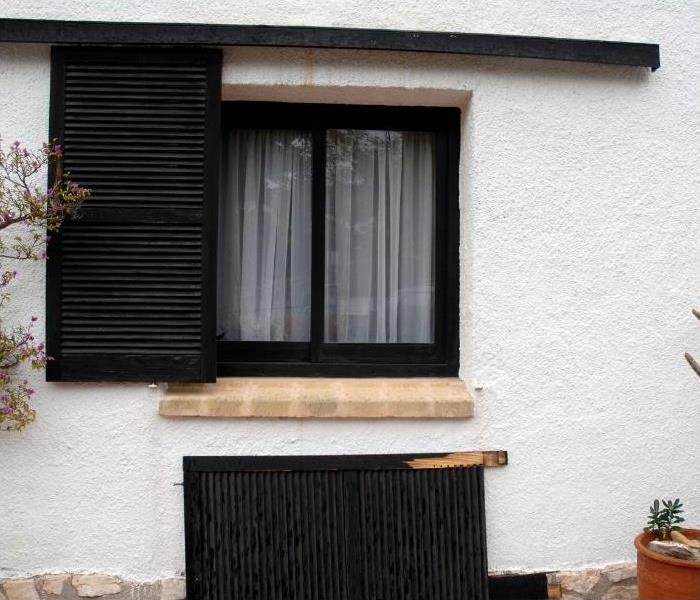 Preparing your property and staying on top of maintenance can help minimize the impact of severe weather.
Preparing your property and staying on top of maintenance can help minimize the impact of severe weather.
Key Takeaways:
- Regular property maintenance is essential to prevent storm damage
- Protecting windows and doors can reduce the risk of damage
- Proper tree maintenance and removal can prevent damage to property
- Having a plan in place and knowing what to do after a storm can help minimize damage and restoration costs
As a homeowner or property manager, storm damage can be a nightmare to deal with. From water damage to wind damage, storms can cause significant harm to your property, not to mention the added stress and expense of cleaning up and restoring your property to its former state. However, there are many steps you can take to prevent storm damage and minimize the impact of any severe weather that may come your way.
Inspect Your Property Regularly
One of the best things you can do to prevent storm damage is to inspect your property regularly. Check your gutters for debris and ensure they are properly installed and free of any leaks. Inspect your roof for missing shingles, cracks, or other signs of damage. Look for any signs of damage or wear on your doors, windows, and siding. Make sure your trees are trimmed and free from any dead or weak branches that could fall during a storm. These simple inspections can help you identify potential problem areas before they turn into costly repairs.
Prepare Your Property for Severe Weather
Another critical step in preventing storm damage is to prepare your property for severe weather. If you live in an area prone to high winds, it’s a good idea to install storm shutters or impact-resistant windows to protect your home’s windows. If you live in an area prone to flooding, make sure you have a sump pump and a backup generator to keep your basement dry in the event of a power outage. If you live in an area prone to hurricanes, make sure your roof is properly secured to your home’s frame and consider installing hurricane straps to prevent your roof from separating during high winds.
Keep Up with Maintenance
Regular maintenance is essential for preventing storm damage. Clean your gutters at least twice a year to prevent water damage from overflowing gutters. Trim your trees regularly to prevent dead branches from falling during a storm. Make sure your roof is inspected annually for signs of wear and tear. Keep your siding, windows, and doors in good repair to prevent water from entering your home. Regular maintenance may seem like a hassle, but it’s much easier and less expensive than dealing with storm damage after the fact.
Know When to Call in the Professionals
Despite your best efforts, sometimes storm damage is unavoidable. In these cases, it’s important to know when to call in the professionals. SERVPRO of South and Northwest Grand Rapids is always ready to help with storm damage restoration efforts. Our team of experts can help with everything from water extraction and mold remediation to repairing structural damage and restoring your property to its former state. Don’t try to tackle storm damage restoration on your own – call in the experts at SERVPRO of South and Northwest Grand Rapids for fast, reliable service.
Final Thoughts
While it’s impossible to prevent all storm damage, taking the time to prepare your property and stay on top of maintenance can help minimize the impact of severe weather. By following the tips outlined in this article, you can rest easy knowing that you’ve done everything possible to protect your property from storm damage. And if the worst does happen, SERVPRO of South and Northwest Grand Rapids is always here to help with storm damage restoration efforts. Contact us today to learn more about our services and how we can help protect your property.
3 Damage Myths You Can’t Ignore After a Storm
7/17/2023 (Permalink)
 At SERVPRO of South and Northwest Grand Rapids, we understand the challenges of storm damage restoration.
At SERVPRO of South and Northwest Grand Rapids, we understand the challenges of storm damage restoration.
Key Takeaways:
- Don’t believe the myth that all storm damage is visible
- Beware of contractors offering “too good to be true” deals
- Understand the importance of proper storm damage assessment
- Work with a reputable restoration company for quality repairs
When a storm hits, it can leave behind a trail of destruction. From fallen trees to damaged roofs, it’s important to act quickly to mitigate further damage and begin the restoration process. However, it’s also important to separate fact from fiction when it comes to storm damage. Here are three common myths about storm damage you shouldn’t ignore.
Myth #1: If There’s No Visible Damage, There’s No Damage at All
Just because there’s no visible damage to your property doesn’t mean that there’s no damage at all. Many types of damage may not be immediately visible, but can cause long-term problems if left unchecked. For example, water damage from a leaky roof can lead to mold growth and compromise the structural integrity of your home. It’s important to have a professional inspection to ensure that your property is truly in good condition.
Myth #2: DIY Repairs Are Just as Effective as Professional Repairs
It may be tempting to save money by attempting to make repairs yourself, but DIY repairs can often lead to more problems down the line. Without the proper training and equipment, you may not identify all the damage that needs to be addressed, leading to incomplete repairs that leave your property vulnerable to future damage. Professional restoration companies like SERVPRO of South and Northwest Grand Rapids have the expertise and experience to properly assess and address storm damage.
Myth #3: Coverage for Storm Damage
While it's true that there are financial options available for the restoration of storm damage, it's important to note that not all forms of damage are included. For instance, if the damage is a result of insufficient maintenance or neglect, the costs of repairs may not be covered. To ensure clarity on what is covered, it is essential to carefully review your policy and consult with professionals in the field.
Final Thoughts
When it comes to storm damage restoration, it’s important to separate fact from fiction. Myths about damage can lead to improper repairs, additional damage, and unnecessary expenses. By understanding the truth about storm damage, you can make informed decisions about the restoration process and ensure that your property is fully restored to its pre-storm condition.
At SERVPRO of South and Northwest Grand Rapids, we understand the challenges of storm damage restoration. That’s why we offer comprehensive restoration services to help you get your property back to its pre-storm condition quickly and efficiently. Contact us today to learn more about our services.
Top 3 Things that Cause the Most Property Damage During Storms
7/13/2023 (Permalink)
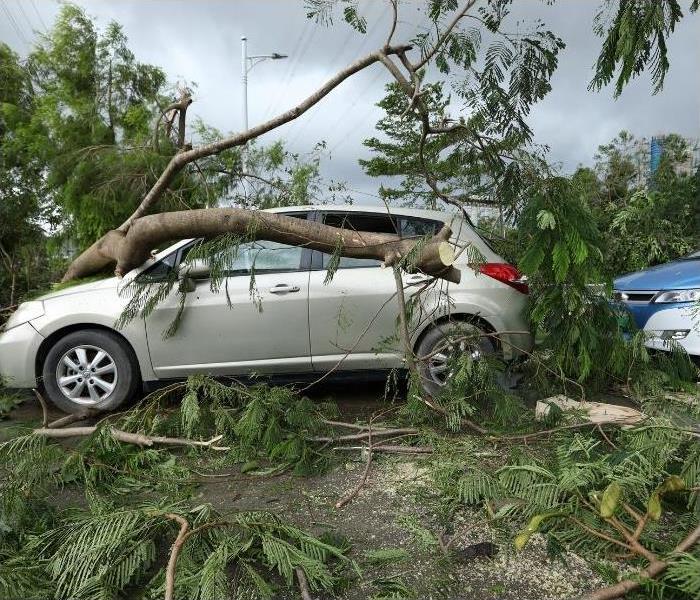 SERVPRO of South and Northwest Grand Rapids can provide storm cleanup services.
SERVPRO of South and Northwest Grand Rapids can provide storm cleanup services.
Key Takeaways:
- Water damage is the most common cause of storm-related property damage.
- Strong winds and fallen trees can cause severe structural damage to buildings.
- Power outages can lead to secondary damages such as mold growth.
- SERVPRO of South and Northwest Grand Rapids can provide storm cleanup services.
Storms can cause severe damage to properties, and the aftermath can be both time-consuming and expensive to fix. As a property manager or homeowner, it’s essential to be aware of the most common causes of storm-related property damage and what you can do to minimize the risks. Here are the top three things that cause the most property damage during storms and tips on how to prepare your property to withstand extreme weather conditions.
1. Strong Winds
Strong winds are one of the most destructive forces during a storm. They can cause significant damage to roofs, windows, and siding, leading to water damage and even structural damage. In extreme cases, strong winds can uproot trees and knock down power lines, resulting in power outages and fire hazards.
How to Prepare:
- Trim trees and remove dead branches before a storm hits.
- Secure outdoor furniture, decorations, and other items that can become projectiles in high winds.
- Make sure windows and doors are sealed and reinforced to withstand high winds.
What to Do After a Storm:
- Inspect your property for any damage caused by strong winds.
- Contact SERVPRO of South and Northwest Grand Rapids to assess the damage and start the restoration process.
2. Heavy Rain and Flooding
Heavy rain and flooding can cause significant water damage to a property, especially if the water is left standing for an extended period. Water can seep into walls, floors, and ceilings, causing mold growth and structural damage. In addition, flooding can lead to electrical hazards, as water can conduct electricity and pose a risk to people and pets.
How to Prepare:
- Clean gutters and downspouts to ensure water flows away from your property.
- Install a sump pump in the basement to remove excess water.
- Raise electrical components and appliances off the ground to prevent water damage.
What to Do After a Storm:
- Turn off the power and gas to your property to avoid electrical hazards and gas leaks.
- Remove standing water as soon as possible to prevent mold growth.
- Contact SERVPRO of South and Northwest Grand Rapids to remove water, dry out your property, and prevent further damage.
3. Hailstorms
Hailstorms can cause extensive damage to a property’s roof, siding, and windows. The force of the hail can create holes, dents, and cracks, which can lead to water damage and mold growth if not addressed promptly.
How to Prepare:
- Install impact-resistant roofing and siding materials.
- Keep trees trimmed to prevent branches from breaking off and damaging your property.
- Secure outdoor items that can become projectiles in a hailstorm.
What to Do After a Storm:
- Inspect your property for any damage caused by hail.
- Contact SERVPRO of South and Northwest Grand Rapids to assess the damage and start the restoration process.
Final Thoughts
Storms can cause significant damage to properties, but being aware of the most common causes of storm-related property damage can help you prepare and protect your property. Whether it’s strong winds, heavy rain and flooding, or hailstorms, taking steps to prepare your property before a storm and taking swift action after a storm can minimize the risks and help you avoid costly repairs. If your property has been affected by storm damage, contact SERVPRO of South and Northwest Grand Rapids to restore your property to its pre-storm condition.
Tree Removal Is a Routine Part of Storm Damage Restoration
7/10/2023 (Permalink)
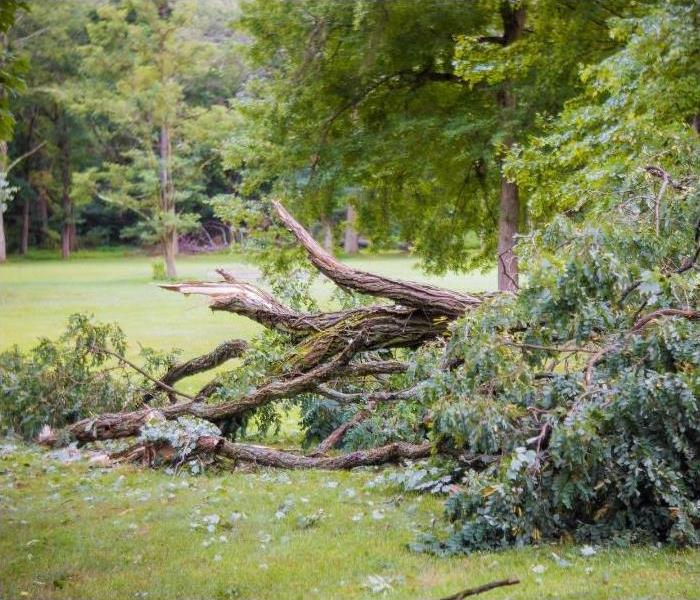 SERVPRO offers tree removal services as part of storm restoration.
SERVPRO offers tree removal services as part of storm restoration.
Key Takeaways:
- Tree removal is an important safety measure after storms.
- Hazardous trees should be removed before a storm hits.
- Professional tree removal is the safest option.
- SERVPRO offers tree removal services as part of storm restoration.
How Important Is Tree Removal?
Trees are essential parts of our landscapes and can provide shade, beauty, and a natural habitat for wildlife. However, after a storm, trees can become dangerous and need to be removed for safety reasons. Even seemingly healthy trees can become distressed after a storm, making them vulnerable to falling branches or complete collapse. A falling tree or branch can cause serious injury or even death. Damaged trees can fall on power lines, causing power outages and other issues.
Distressed trees can pose a serious hazard and should be removed promptly, regardless of visible damage.
Removing distressed trees from your property is a crucial step in ensuring the safety of your family, visitors, and neighbors. If you’re unsure if a tree needs to be removed, contact the professionals at SERVPRO of South and Northwest Grand Rapids for an evaluation.
How Tree Removal Works
Tree removal is a complex process that should only be handled by trained professionals. The process typically involves several steps:
1. Evaluation
The first step in the tree removal process is to evaluate the tree’s health and determine the best course of action. If the tree is in immediate danger of falling or causing harm, it may need to be removed as soon as possible.
2. Tree Cutting
Once the tree has been evaluated, the tree removal team will begin cutting the tree. They’ll start by removing any large branches, then work their way down the trunk until the tree is completely cut down.
3. Stump Removal
After the tree has been cut down, the stump will need to be removed. Depending on the size of the stump, this may involve grinding the stump down or excavating it.
4. Debris Removal
Once the tree and stump have been removed, the debris will need to be cleaned up. The tree removal team will typically chip the branches and haul away the wood and other debris.
How SERVPRO of South and Northwest Grand Rapids Can Help
If your property has been damaged by a storm, the professionals at SERVPRO of South and Northwest Grand Rapids can help with all aspects of storm damage restoration, including tree removal. We have the experience and equipment necessary to safely and efficiently remove damaged trees from your property. We’ll evaluate the tree’s health, determine the best course of action, and handle all aspects of the tree removal process, including stump removal and debris cleanup.
We understand how stressful and overwhelming it can be to deal with storm damage. That’s why we’re here to help. We’ll work with you every step of the way to ensure that your property is restored to its pre-storm condition quickly and safely.
Final Thoughts
Tree removal is an important part of storm damage restoration. Distressed trees can pose a serious hazard and should be removed promptly after a storm. The professionals at SERVPRO of South and Northwest Grand Rapids can help with all aspects of tree removal, from evaluation to debris cleanup. If your property has been damaged by a storm, contact us. We’re here to help you get back to normal.
The Importance of Cleanup and Sanitization After a Storm
7/3/2023 (Permalink)
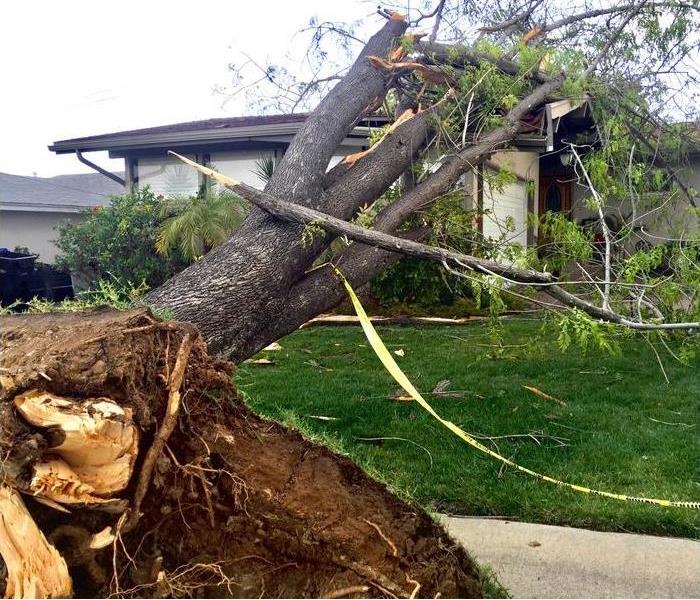 It is important to clean up after a storm, and SERVPRO of South and Northwest Grand Rapids can. help!
It is important to clean up after a storm, and SERVPRO of South and Northwest Grand Rapids can. help!
Key Takeaways
- Storm damage can cause health risks and long-term damage.
- Cleanup removes debris and hazards from the property.
- Sanitization eliminates harmful bacteria and viruses.
- Professional storm damage restoration services ensure a safe living environment.
When a storm hits, it can leave behind a path of destruction that can cause significant damage to homes and other properties. While most people are focused on the immediate aftermath of the storm, the importance of cleanup and sanitization can’t be overstated. In fact, it’s crucial to ensure that the property is thoroughly cleaned and sanitized after a storm event to avoid any potential health risks and long-term damage.
At SERVPRO of South and Northwest Grand Rapids, we understand the importance of storm damage cleanup and sanitization. That’s why we’ve put together this article to explain why it’s so important and how we can help you restore your property to its pre-storm condition.
The Lasting Effects of Storms
The aftermath of a storm can be devastating, both emotionally and physically. Not only can a storm damage your property, but it can also lead to health problems if not properly cleaned up. Storms can create conditions that are ideal for mold growth, which can lead to respiratory problems and other health issues. Standing water can create the perfect breeding ground for bacteria and viruses, which can cause serious illness.
The Importance of Cleanup
The first step in storm damage restoration is cleanup. When a storm strikes, it can leave behind debris, broken glass, and other hazards that can be dangerous if not removed quickly. SERVPRO of South and Northwest Grand Rapids has the experience and equipment necessary to safely and effectively remove debris from your property. Our team will also inspect your property for any hidden damage that may have been caused by the storm.
The Importance of Sanitization
In addition to cleanup, sanitization is also essential after a storm. Sanitization involves the use of specialized cleaning agents and equipment to eliminate any harmful bacteria and viruses that may be present. Our team of experts will thoroughly sanitize your property to ensure that it’s safe for you and your family to return.
How We Can Help
If you’ve experienced storm damage, it’s important to act quickly. At SERVPRO of South and Northwest Grand Rapids, we offer a wide range of storm damage restoration services to help you get your life back to normal as quickly as possible. Our team of professionals has the experience and expertise necessary to handle any storm damage restoration project, no matter how big or small.
Our services include:
- Emergency response 24/7
- Water extraction and drying
- Debris removal and cleanup
- Mold remediation
- Sanitization and disinfection
Final Thoughts
Storms can be incredibly powerful and destructive, but the aftermath of a storm can be just as dangerous if proper cleanup and sanitization aren’t carried out. At SERVPRO of South and Northwest Grand Rapids, we understand the importance of storm damage restoration and are committed to helping our clients get back on their feet after a storm event. Contact us today to learn more about our storm damage restoration services and how we can help you restore your property to its pre-storm condition.
What Needs Replacing After Storm Damage?
6/19/2023 (Permalink)
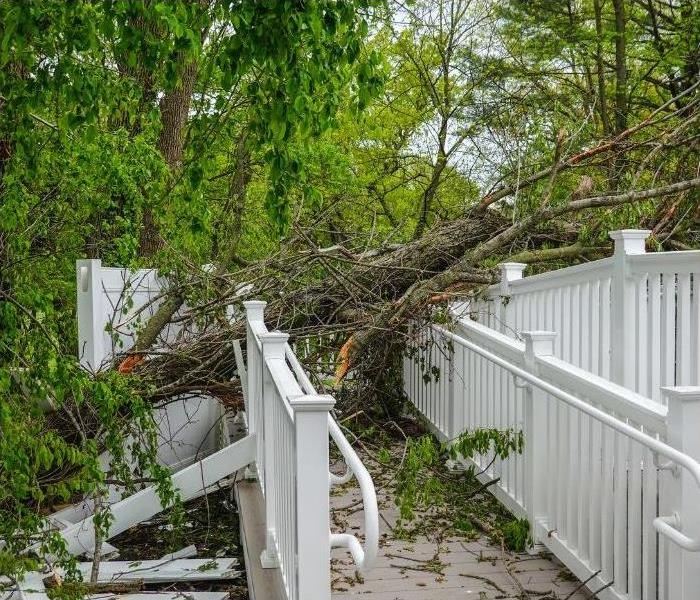 What needs replacing after storm damage? Allow SERVPRO to guide you through the process.
What needs replacing after storm damage? Allow SERVPRO to guide you through the process.
Key Takeaways
- Safety first, evacuate the area if necessary
- Salvageable items should be inspected before replacing
- Roof, water, and electrical damage are common issues
- Professional inspections and repairs are necessary for safety and restoration
Extreme weather can cause significant property damage, leaving homeowners and property managers scrambling to figure out what needs replacing after storm damage. Whether it’s heavy winds, torrential rains, or hail, these weather events can wreak havoc on your property and leave you with costly repairs. But fear not, with the help of SERVPRO of South and Northwest Grand Rapids, you can restore your property to its pre-storm condition and ensure that any necessary replacements are made quickly and efficiently.
First Steps After Storm Damage
The first step in any storm damage restoration process is to assess the damage and determine what needs replacing. When extreme weather occurs, it’s crucial to prioritize safety first. Assess the damage to your property and check for any hazards such as downed power lines or gas leaks. If there are any safety concerns, evacuate the area immediately and contact the appropriate authorities. Once the area is deemed safe, you can begin assessing the damage to your property.
What Can be Salvaged?
Not everything damaged by a storm will need to be replaced. Salvageable items should be inspected by professionals to ensure that they are safe and functional. For example, if a tree limb falls on your roof, you may need to replace the shingles but not the entire roof. SERVPRO of South and Northwest Grand Rapids will inspect all salvageable items and provide recommendations on whether they need to be replaced or repaired.
Roof Damage
Roof damage is one of the most common types of property damage caused by storms. High winds, hail, and falling debris can cause shingles to become dislodged or damaged, leaving your roof vulnerable to leaks and other issues. If you suspect that your roof has been damaged, it’s essential to have it inspected by professionals as soon as possible. Sometimes, a simple repair may be all that’s needed, but in severe cases, a full replacement may be necessary.
Water Damage
Water damage is another common issue that arises after storms. Heavy rains can cause flooding, leading to water damage to floors, walls, and furniture. When left untreated, water damage can lead to mold growth, which can cause health issues. It’s crucial to have water damage inspected by professionals to determine the extent of the damage and what needs replacing. Carpets, drywall, and furniture may need to be replaced if the damage is severe.
Electrical Damage
Storms can also cause electrical damage, leaving your property without power. If you suspect that your property has electrical damage, it’s crucial to have it inspected by professionals. Electrical damage can be dangerous, and attempting to fix it on your own can cause injury or death. SERVPRO of South and Northwest Grand Rapids has trained professionals who can safely inspect and repair any electrical damage to your property.
Final Thoughts
When extreme weather occurs, it can cause significant damage to your property. But with the help of SERVPRO of South and Northwest Grand Rapids, you can restore your property to its pre-storm condition. Understanding what needs replacing after storm damage is essential for making full repairs and restoring normalcy to your residence as quickly as possible. If you have experienced storm damage, contact us for assistance. Our professionals are available 24/7 to provide you with the help you need.
3 Damage Myths You Can’t Ignore After a Storm
5/24/2023 (Permalink)
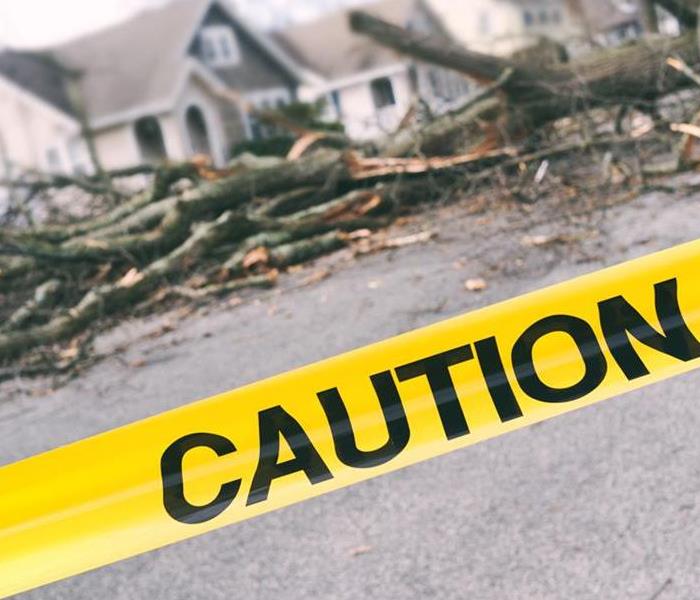 Storm damage is never expected, it's a good idea to make sure you're covered where possible.
Storm damage is never expected, it's a good idea to make sure you're covered where possible.
Key Takeaways:
- Don’t believe the myth that all storm damage is visible
- Beware of contractors offering “too good to be true” deals
- Understand the importance of proper storm damage assessment
- Work with a reputable restoration company for quality repairs
When a storm hits, it can leave behind a trail of destruction. From fallen trees to damaged roofs, it’s important to act quickly to mitigate further damage and begin the restoration process. However, it’s also important to separate fact from fiction when it comes to storm damage. Here are three common myths about storm damage you shouldn’t ignore.
Myth #1: If There’s No Visible Damage, There’s No Damage at All
Just because there’s no visible damage to your property doesn’t mean that there’s no damage at all. Many types of damage may not be immediately visible, but can cause long-term problems if left unchecked. For example, water damage from a leaky roof can lead to mold growth and compromise the structural integrity of your home. It’s important to have a professional inspection to ensure that your property is truly in good condition.
Myth #2: DIY Repairs Are Just as Effective as Professional Repairs
It may be tempting to save money by attempting to make repairs yourself, but DIY repairs can often lead to more problems down the line. Without the proper training and equipment, you may not identify all the damage that needs to be addressed, leading to incomplete repairs that leave your property vulnerable to future damage. Professional restoration companies like SERVPRO of South and Northwest Grand Rapids have the expertise and experience to properly assess and address storm damage.
Myth #3: Coverage for Storm Damage
While it's true that there are financial options available for the restoration of storm damage, it's important to note that not all forms of damage are included. For instance, if the damage is a result of insufficient maintenance or neglect, the costs of repairs may not be covered. To ensure clarity on what is covered, it is essential to carefully review your policy and consult with professionals in the field.
Are you ready?
When it comes to storm damage restoration, it’s important to separate fact from fiction. Myths about damage can lead to improper repairs, additional damage, and unnecessary expenses. By understanding the truth about storm damage, you can make informed decisions about the restoration process and ensure that your property is fully restored to its pre-storm condition.
At SERVPRO of South and Northwest Grand Rapids, we understand the challenges of storm damage restoration. That’s why we offer comprehensive restoration services to help you get your property back to its pre-storm condition quickly and efficiently. Contact us today to learn more about our services.
The Role of Tree Removal in Storm Damage Restoration
4/23/2023 (Permalink)
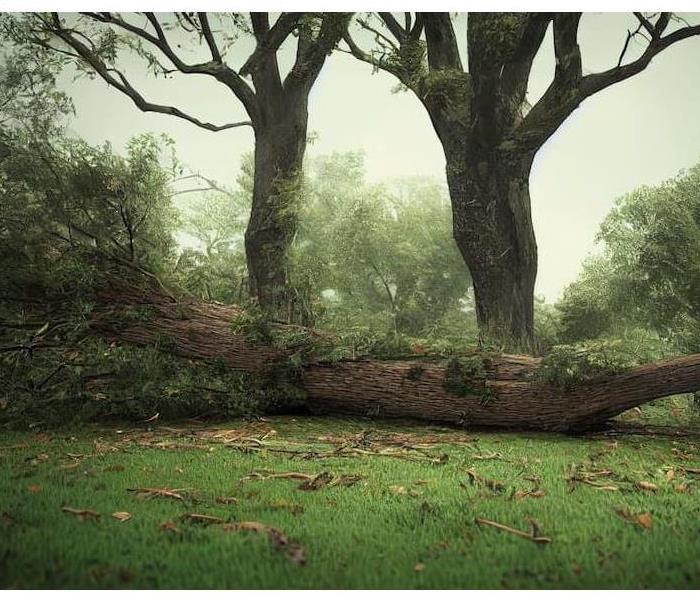 Large debris, like downed trees, should only be removed by those with expert knowledge and the right equipment.
Large debris, like downed trees, should only be removed by those with expert knowledge and the right equipment.
Trees are often seen as a form of protection and a natural asset to any home. Occasionally, their presence can cause more harm than good. Heavy storms can cause fallen tree branches and uprooted trees, which in turn can lead to structural damage or other more serious property damage. Removing these trees is essential if you want your home restored to its pre-storm condition. This is where tree removal becomes important in storm damage restoration.
How Storms Damage Trees
Heavy storms can damage trees in a variety of ways. From uprooting entire trees to breaking branches, the force of wind or hail can pose a serious risk to trees. When this happens, it is essential to consider the role of tree removal in storm damage restoration.
Removing Trees after Storms
When a tree is uprooted, it can cause damage to property, people, and other trees. It is important to promptly remove the trees to prevent additional damage.
Once the tree is removed, it is important to assess the damage and take steps to restore the area. This includes removing any debris as well as repairing damaged structures and trees. In some cases, the damage may be too extensive to repair, and it is necessary to replace sections of the landscape.
Tree Removal as Part of Storm Damage Restoration
Tree removal can be a critical part of storm damage restoration. Removing damaged trees and debris will help limit the damage to your property and ensure that the restoration process is efficient and successful.
Tree removal can be difficult, so it's important to work with an experienced team that knows what they're doing. A professional restoration will safely and efficiently remove damaged trees and debris and any additional debris that the storm may have created.
Tree Removal Services
When a storm strikes, having the right tree removal services on board can make all the difference in restoring your home. Tree removal experts have the necessary experience and equipment to safely remove trees that may have been uprooted or fallen due to strong winds or other storm-related issues.
This type of service helps minimize the damage caused by fallen trees and other debris, as well as helps to restore your home more quickly.
The Process of Tree Removal
The process of tree removal involves more than just cutting down trees. Professional tree removal companies will use various techniques to safely remove trees from any location. This includes using specialized equipment such as cranes, ladders, and rigging systems to reach areas where manual removal may not be possible. After being cut down, it is removed from the property in pieces.
The Benefits of Professionals
One key benefit of hiring a professional tree removal company is that they can safely remove trees and limbs from any location, even in tight spaces or hard-to-reach areas. Professional tree removal services also have the necessary insurance and certifications to operate in your area. This means you won't have to worry about potential liability costs if the job is done incorrectly.
Professionals have access to special equipment and tools that make removing trees and debris easier. Some of these tools include chainsaws, pulleys, winches, and ladders. This equipment can help to get the job done faster and more safely than attempting to do it yourself with basic tools.
A professional tree removal company can assess the damage caused by a storm and advise you on what needs to be done. They can provide you with a detailed plan of action to help minimize the damage.
These qualities help ensure that all work is done safely and efficiently, with minimal risk of further damage to your property. The aftermath of a storm can be overwhelming. To ensure that your restoration process goes as smoothly as possible, it is important to hire a professional tree removal company. They will have the right tools and knowledge necessary to remove trees safely and provide you with peace of mind.
Why Contact SERVPRO?
At SERVPRO of South and Northwest Grand Rapids, we have the experience and training to ensure that your storm damage restoration is done quickly and safely. We are a trusted source for professional tree removal services and can provide you with the guidance and support needed to restore your property. We provide the best services, from tree removal to clean-up and debris removal, so you can rest assured that your property is being taken care of.
If your home or business has been affected by a storm, contact SERVPRO of South and Northwest Grand Rapids at (616) 662-9700 with any questions. Our team of experts is available 24/7 and can help get your property back to normal in no time.
How Do Storms Damage Roofs?
4/9/2023 (Permalink)
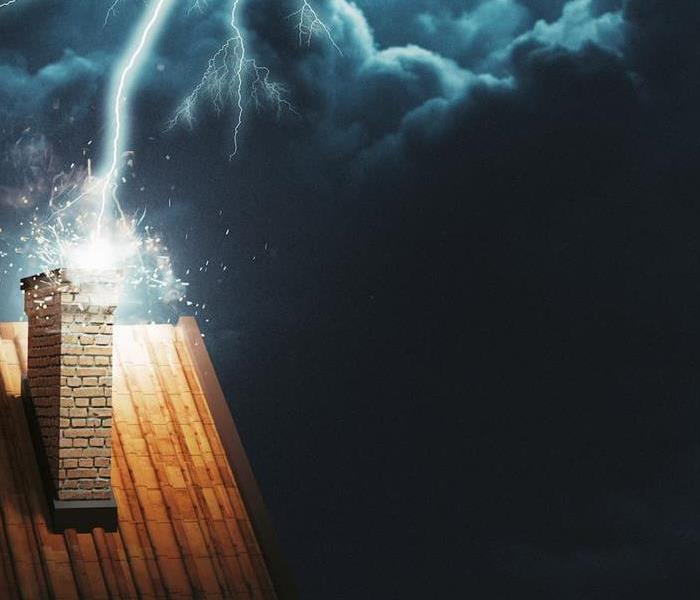 If a storm causes damage to your roof, it's important to act quickly.
If a storm causes damage to your roof, it's important to act quickly.
Storms can cause serious damage to a roof. From high winds to hail, these severe weather events can wreak havoc on well-maintained roofs. The most common types of storm damage are wind, hail, snow and ice, and lightning. Each type of storm presents a different risk to your roof and its own set of challenges when trying to repair the damage.
While roofs are designed to withstand strong weather, there is only so much they can do against the power of a storm. Knowing what to watch for and how to prepare before a storm hit can help you minimize the potential damage and keep your roof in great shape.
Different Types of Storms
The type of storm can have a huge impact on the damage it does to your roof.
Hail
Hail can cause a range of damage to your roof, depending on the size and speed of the hail. Smaller hail may just dent or scratch the surface of your roof, while larger hail can cause cracks and punctures. If your roof is made from asphalt shingles, hail can cause the granules on top to be knocked off. This reduces the protection of your roof and may lead to more serious issues down the line.
Heavy Rain
Hail storms can cause dents and holes, but heavy rain can be even more damaging. During a storm, rainfall increases the pressure on your roof, which can cause water to seep through the seams of your roof, resulting in water damage. Heavy rains can also overwhelm gutters, leading to water spilling over the sides of your roof and causing more damage.
High Winds
High winds during a storm can cause shingles to be torn away, leaving your roof exposed and vulnerable to water damage. The force of the wind can also break the branches from the trees, which can then crash through your roof. If there are any weak spots on your roof—such as missing or damaged shingles—the wind can take advantage of these and cause further damage.
What to Do to Prepare
To minimize the potential damage of storms, it's important to take steps before a storm hits. There are a few things you can do to help prevent storm damage and minimize the risk of a roof leak:
- Check your roof for weak spots, missing shingles, and other signs of damage before storms begin.
- Check your gutters to make sure they aren't clogged and can efficiently drain away water.
- Check missing or damaged shingles after a storm to see whether they can be replaced or patched.
- Ensure your attic is properly ventilated, and check for any signs of water leaks or damp spots.
- It's also important to trim any branches away from your home to reduce the risk of falling debris.
- Ensure that you have adequate and up-to-date insurance coverage on your home.
If a storm causes damage to your roof, it's important to act quickly. Remove any debris from your roof, and inspect the damage to determine if you need to call a professional. Ensure all the affected areas are properly sealed and covered to prevent further damage. If you're concerned that your roof may have been damaged in a storm, contact a professional roofer for an inspection. They can determine the extent of the damage and make recommendations for repairs or replacement.
No matter how severe the damage, it's important to take action quickly. Storms can cause extensive damage to your roof, so don't delay getting help. If you're unsure of how to proceed, contact SERVPRO of South and Northwest Grand Rapids at (616) 662-9700 with any questions, we're here to help!
We'll provide you with a thorough assessment and make sure your roof is as secure as possible. Don't let storm damage get the best of you: contact us today and put your mind at ease.
How Do Storms Damage Roofs?
3/28/2023 (Permalink)
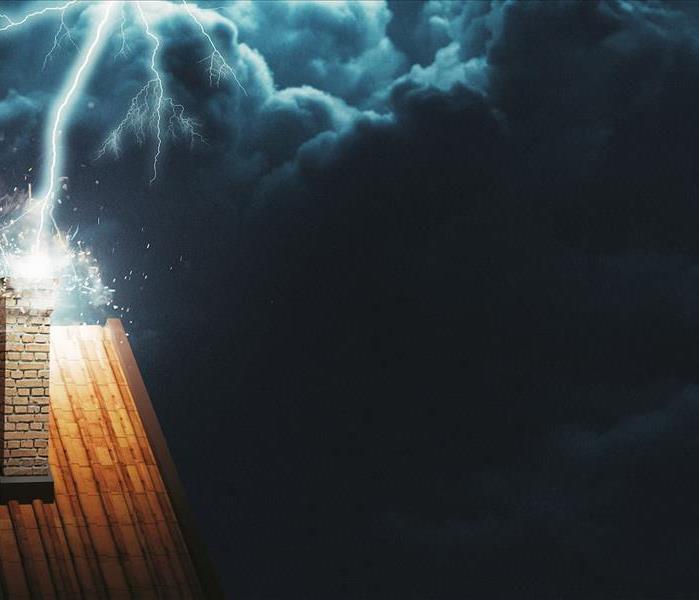 If a storm causes damage to your roof, it's important to act quickly.
If a storm causes damage to your roof, it's important to act quickly.
Storms can cause serious damage to a roof. From high winds to hail, these severe weather events can wreak havoc on well-maintained roofs. The most common types of storm damage are wind, hail, snow and ice, and lightning. Each type of storm presents a different risk to your roof and its own set of challenges when trying to repair the damage.
While roofs are designed to withstand strong weather, there is only so much they can do against the power of a storm. Knowing what to watch for and how to prepare before a storm hit can help you minimize the potential damage and keep your roof in great shape.
Different Types of Storms
The type of storm can have a huge impact on the damage it does to your roof.
Hail
Hail can cause a range of damage to your roof, depending on the size and speed of the hail. Smaller hail may just dent or scratch the surface of your roof, while larger hail can cause cracks and punctures. If your roof is made from asphalt shingles, hail can cause the granules on top to be knocked off. This reduces the protection of your roof and may lead to more serious issues down the line.
Heavy Rain
Hail storms can cause dents and holes, but heavy rain can be even more damaging. During a storm, rainfall increases the pressure on your roof, which can cause water to seep through the seams of your roof, resulting in water damage. Heavy rains can also overwhelm gutters, leading to water spilling over the sides of your roof and causing more damage.
High Winds
High winds during a storm can cause shingles to be torn away, leaving your roof exposed and vulnerable to water damage. The force of the wind can also break the branches from the trees, which can then crash through your roof. If there are any weak spots on your roof—such as missing or damaged shingles—the wind can take advantage of these and cause further damage.
What to Do to Prepare
To minimize the potential damage of storms, it's important to take steps before a storm hits. There are a few things you can do to help prevent storm damage and minimize the risk of a roof leak:
- Check your roof for weak spots, missing shingles, and other signs of damage before storms begin.
- Check your gutters to make sure they aren't clogged and can efficiently drain away water.
- Check missing or damaged shingles after a storm to see whether they can be replaced or patched.
- Ensure your attic is properly ventilated, and check for any signs of water leaks or damp spots.
- It's also important to trim any branches away from your home to reduce the risk of falling debris.
- Ensure that you have adequate and up-to-date insurance coverage on your home.
If a storm causes damage to your roof, it's important to act quickly. Remove any debris from your roof, and inspect the damage to determine if you need to call a professional. Ensure all the affected areas are properly sealed and covered to prevent further damage. If you're concerned that your roof may have been damaged in a storm, contact a professional roofer for an inspection. They can determine the extent of the damage and make recommendations for repairs or replacement.
No matter how severe the damage, it's important to take action quickly. Storms can cause extensive damage to your roof, so don't delay getting help. If you're unsure of how to proceed, contact SERVPRO of South and Northwest Grand Rapids at (616) 662-9700 with any questions, we're here to help!
We'll provide you with a thorough assessment and make sure your roof is as secure as possible. Don't let storm damage get the best of you: contact us today and put your mind at ease.
What Is Considered Storm Damage to a Roof?
1/13/2023 (Permalink)
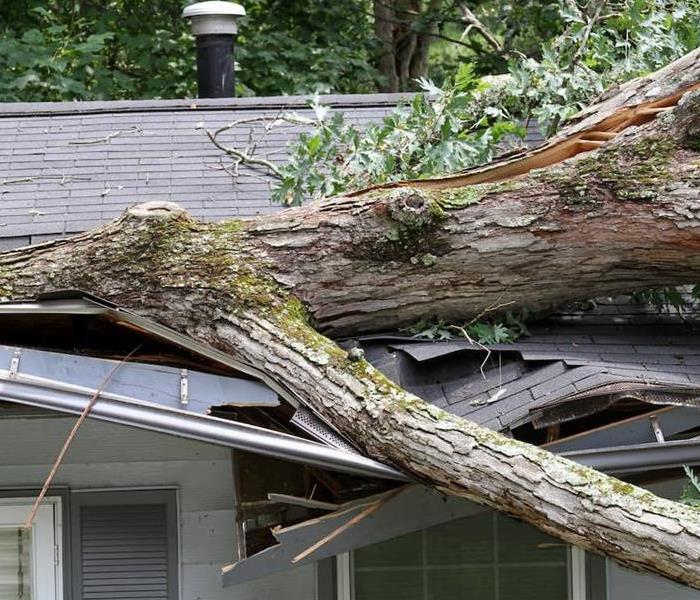 Some signs of storm damage are more apparent than others.
Some signs of storm damage are more apparent than others.
When severe weather strikes, the damage to your house can be extensive. Without a proper assessment, it's impossible to know the extent of the damage. One area that is particularly vulnerable to storm damage is the roof. Knowing what constitutes storm damage to your roof can help you understand what kind of repairs you need to make and how urgent the situation is.
What Are the Signs of Storm Damage?
When assessing storm damage to your roof, several indicators should be considered. Hail damage is one of the most common indicators of roof damage, as hail can cause dents or punctures in shingles. Wind damage can also be a sign, as strong winds can easily tear off or lift shingles. Additionally, look for signs of water damage, such as water stains or water leaking inside your home.
It's also important to inspect the interior of your home for signs of roof damage, such as cracked or bubbled paint, stained ceilings and walls, and musty smells. If you notice any of these signs, it's important to call for help as soon as possible.
Some signs to look out for include:
- Missing or broken shingles
- Evidence of water infiltration
- Visible dents or gouges in the roof
- Exposed nails or other hardware on the roof surface
- Loose or missing seals around vents, chimneys, and skylights
- Trees or other debris that have fallen on the roof
- Flashing that has become loose or detached.
Remember that some of these indicators may not be immediately apparent. That is why it's important to have a trained professional evaluate your roof after a storm event.
What to Do after Storm Damage
If you suspect that your roof has suffered storm damage, it's essential to take action immediately. Even if you think the damage is minor, waiting too long can lead to more costly repairs.
The first step is to contact a qualified roofing contractor who can assess the damage and provide an estimate for repairs. Make sure the contractor has experience in dealing with storm-damaged roofs, as they will be able to recognize potential issues that are not always obvious.
Once the damage has been assessed, the contractor can recommend repairs or replacement of the affected areas. If repair is necessary, they can estimate the cost of the repairs.
In some cases, however, a full roof replacement may be necessary. If this is the case, getting several estimates from different contractors is crucial to ensure you get the best deal.
Repercussions of Unrepaired Storm Damage
If left unaddressed, storm damage can further damage your home's roof. Fallen trees and debris can cause holes in the roof, allowing water to seep in and accumulate, which can increase the risk of mold growth. Mold can spread quickly and cause health issues such as respiratory and allergen problems to those living in the home, even if they are not directly exposed to the mold.
In addition to health issues, mold can cause further structural damage leading to costly repairs down the line. Strong storm winds can cause shingles to erode, leading to water damage in the attic and other areas. Water damage can also cause roof deterioration, leading to additional repairs and even replacement if not taken care of promptly.
It's important to contact a professional roofing company as soon as possible after a storm to inspect and assess the damage and make any necessary repairs.
At SERVPRO of South and Northwest Grand Rapids, we're experienced in helping homeowners assess and repair storm damage. We use the latest technology to quickly and efficiently inspect your roof, evaluate the damage and recommend a course of action. If repairs are necessary, our team of professionals will get the job done quickly and affordably.
Don't let storm damage go unchecked; contact SERVPRO of South and Northwest Grand Rapids at (616) 662-9700 with any questions; we're here to help!
Severe Weather Should Not Take You by Surprise
9/22/2022 (Permalink)
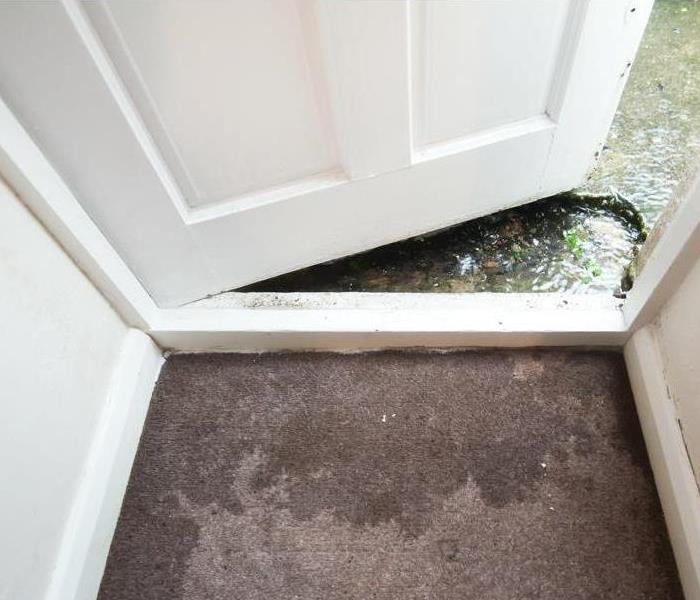 Heavy rains can do more than flood streets. Some waters can meet you at your front door.
Heavy rains can do more than flood streets. Some waters can meet you at your front door.
During severe weather, your house will endure brutal conditions like high winds, heavy rain, and mountains of snow. Take the time to equip your home with accessories to survive a storm. Don't wait until the forecast calls for severe weather because you might not have enough time to make the necessary preparations
Home Architecture
If you're building a new home, ensure it complies with your city's structural regulations. If you live in an area prone to harsh weather, ensure you follow all the building guidelines, making it easier to withstand any weather disasters. For instance, some common rules include a driveway of a certain length and width, building your home on an elevated platform (for floods), a fixed number of rooms and corridors, installing safety devices like fire alarms and smoke detectors, and maintaining your lawn. A clear lawn and backyard with fewer obstructions make evacuation easier.
General Tips
Prepare an emergency evacuation plan to help you get out of the house if under threat. Understand the layout of your home, and mark all doors, corridors, windows, etc., for easier evacuation - practice escape drills every few months to develop route memory of the plan. Build an emergency kit with canned food, water, and disaster control supplies to last at least two days. Create this kit a few days before the weather changes. It is advisable to keep the kit assembled at all times and place it in an easily accessible place since you may not have much time to evacuate. Also, develop a plan to communicate and meet up with your family at a specific spot if everybody isn't together.
House Inspections
Conducting regular home inspections is crucial to withstand severe weather conditions. These inspections should include roof, piping, electric line, and property evaluations. If you find any problems, get them fixed immediately. Delaying the repair will only burden you in bad weather circumstances. For instance, suppose your area experiences a flood. You risk pipelines breaking and cutting off your clean water supply with faulty plumbing.
If you have any issues with electrical lines and a fire breaks out, open or live electricity lines pose a serious threat that can hinder your chances of escape. Property inspections will also help you know if your home's structure follows all disaster management guidelines, and if anything requires changing, you can do it with ease.
When you notice something out of the ordinary, call SERVPRO of South and Northwest Grand Rapids at 616-662-9700. A professional inspection will help you thoroughly prepare your home for any natural disaster.
Preparing for a Tornado, Hurricane, Wildfire, and Thunderstorm
If you live in a tornado-prone zone, your home must have a basement or underground bunker where you can stay until the tornado passes. Ensure your house surroundings don't have fixtures that can be uprooted, like fences.
For hurricane zones, have your home built at the right elevation. If the hurricane is approaching, secure your home by covering windows with storm shutters and installing straps to stabilize your roof.
For areas that experience frequent wildfires, it is essential that your home has a comprehensive fire alarm and smoke detector system. Have many fire extinguishers on hand and learn the fire evacuation procedure in your area.
For thunderstorms, prepare your home well ahead of time by removing any tree branches that could collapse onto your roof. Stabilize your roof and cover all windows with storm shutters. Understand your city's evacuation strategy and storm signals.
Preparing your home to withstand severe weather conditions reduces the damage it endures. Don't be thrown off guard at the last moment by bad weather. These tips will help you thoroughly prepare yourself and your home for any weather conditions.
Prevent Power Surges from Causing Severe Damage
9/22/2022 (Permalink)
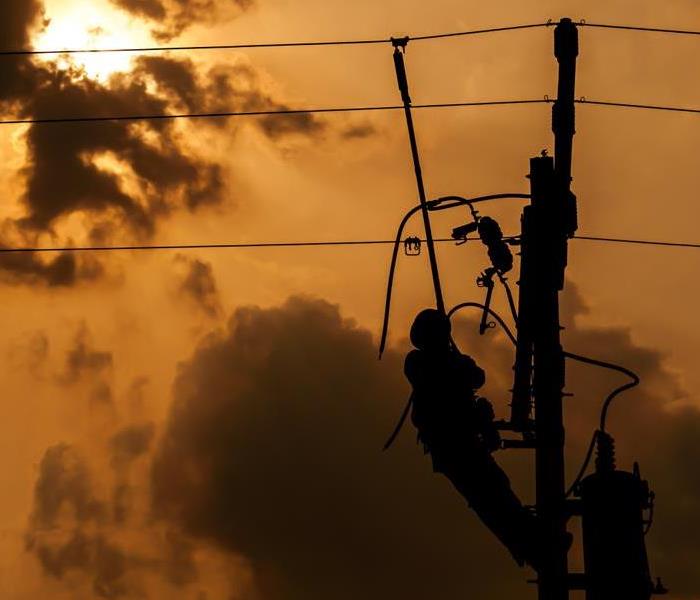 Power surges often happen when transformers are hit by lightning, or when severe storms interfere with power lines.
Power surges often happen when transformers are hit by lightning, or when severe storms interfere with power lines.
We all know power surges can be a pain. They cause our electronics to malfunction, lights to flicker, and appliances to make strange noises. But did you know that power surges also cause severe damage to your home?
What Is a Power Surge?
In electrical terms, a power surge is a sudden surge of power for a brief period. It can occur when lightning strikes, a power line is knocked down, or an appliance is turned on or off. Power surges range from a few volts to thousands of volts and can last for a fraction of a second or several minutes.
While power surges are generally not harmful to people, they can cause serious damage to your home and electronic equipment. In extreme cases, power surges can cause fires. Therefore, it's crucial to take steps to prevent power surges from damaging your home.
How to Prevent Power Surges from Causing Severe Damage
You can do a few things to prevent power surges from causing severe damage to your home:
Install Surge Protectors
Surge protectors are devices that absorb or redirect excess electricity. They can be plugged into outlets and are often used to protect computers, TVs, and other electronics.
They're relatively inexpensive, easy to install and provide peace of mind from a power surge.
Unplug Appliances during a Storm
If thunderstorms are in the forecast, unplug appliances that could be damaged by a power surge, including computers, TVs, stereos, and small appliances.
You can also disconnect your home's main breaker to prevent power surges from occurring in your home.
Storms often knock down power lines, so it's important to be prepared.
Install a Whole-House Surge Protector
A whole-house surge protector is installed on your electrical panel. It protects your entire home from power surges.
A whole-house surge protector is the best option if you live in an area with frequent lightning strikes. Whole-house surge protectors are expensive, but they're worth the investment if you want to protect your home from severe damage.
Use Circuit Breakers
Circuit breakers are devices that shut off power to an electrical circuit when there's too much current. They're usually located in your home's electrical panel.
The circuit breaker will trip and shut off the power before the surge can damage your home when a power surge occurs. It is an effective way to prevent power surges from causing severe damage.
Have a Backup Plan
Even if you take all the precautions listed above, there's still a chance a power surge could damage your home. Therefore, a backup plan is always recommended.
One option is to purchase a UPS (uninterruptible power supply). UPS units come in different sizes, so you'll need to choose one appropriate for your needs.
It's also a good idea to have a backup generator on hand. Generators are used to power all or part of your home during a power outage. Again, you'll need to select a generator according to your needs.
You can always create an emergency power outage kit if you don't want to purchase a UPS or generator. This outage kit should include the essentials you'll need in the event of a power outage, such as flashlights, batteries, non-perishable food, and water.
By taking the time to create a backup plan, you can rest assured knowing you'll be prepared when a power outage occurs.
For professional assistance with your backup plan or other home electrical system issues, contact SERVPRO of South and Northwest Grand Rapids at 616-662-9700. We are vastly experienced in power surge issues. Our professional team will advise you on the best solution. We're always here to help.
September Is National Preparedness Month
9/9/2022 (Permalink)
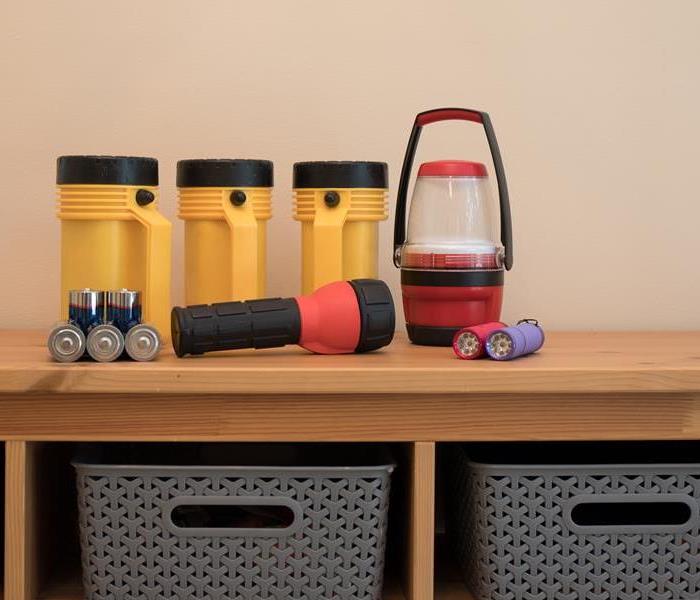 Flashlights, batteries, and other lights sit on a shelf, key ingredients to keep your home alight in case of emergency power outage.
Flashlights, batteries, and other lights sit on a shelf, key ingredients to keep your home alight in case of emergency power outage.
Every year, a month is set aside to raise awareness of the importance of being prepared for crises and natural disasters that could occur at any time. Every year has a theme highlighting the year's major objectives. In addition, activities and planned schedules for each week of September help with achieving these objectives.
The government details a plan for national readiness and creates a list of the most important skills required to make it happen. This plan has five parts: prevention, security, mitigation, response, and recovery. National Preparedness Month is when people, organizations, and communities are encouraged to evaluate and improve their ability to deal with crises and disasters.
How It All Began
The word disaster derives from an Ancient Greek phrase meaning “bad star.” It refers to the idea that bad things happen as a result of planetary alignment. A disaster, crisis, or catastrophe is an event that causes severe damage to people, property, the economy, or the environment. A disaster, whether long-term or short-term, can destabilize society and alter people's perceptions of life. As a result, planning for these events is necessary to avoid helplessness when disasters occur.
The Federal Emergency Management Agency (FEMA) established National Preparedness Month (NPM) three years after the September 11, 2001, attacks to encourage all Americans to make emergency plans. They chose September because of its historical significance and because the Atlantic hurricane season peaks in the middle of this month.
How to Prepare
National Preparedness Month, observed in September, encourages and reminds Americans to be prepared for crises or disasters in their homes, workplaces, and communities. Homeowners, families, neighborhoods, and businesses can use this opportunity to learn more about disaster preparedness, reduce risks to human health and the environment, and educate others.
Here are some simple tips to help you get ready:
Create a Pack
Gather supplies to last a few days after a disaster for everyone in your home. Remember to consider the specific needs of each person or animal if you need to flee quickly.
You should consider a few essential items: plenty of water, snacks like cookies or health bars, portable batteries for cellphones (ensure they are fully charged), and warm clothing like a sweater or rain jacket. Also, any chronic medication that is essential to maintaining your daily health. For your pets, water and food are essential.
Arrange and update your kit according to SERVPRO of South and Northwest Grand Rapids' recommendations.
Plan Ahead
It is important to consider how to avoid these dangers and deal with them if they arise. You and your loved ones should talk about communication during and after a disaster. Check your strategy with SERVPRO of South and Northwest Grand Rapids, whose team is committed to providing services that go above and beyond industry standards.
Contact Professionals
Take steps to minimize the impact of natural disasters on you and your loved ones. Call SERVPRO of South and Northwest Grand Rapids at 616-622-9700 for immediate assistance in the event of an emergency or major disaster. For residential and commercial property, SERVPRO of South and Northwest Grand Rapids has extensive experience restoring properties in the aftermath of a disaster. We prioritize getting you back to normal as quickly as possible with minimum cost.
Recognize the potential for disasters in your area and learn how to fortify your home to withstand storms and other common threats.
Also, check your insurance coverage to ensure it is up to date. We have all had instances where we were unprepared for emergencies. Fortunately, regular preparation for unforeseen circumstances has been shown to save lives and improve corporate results. This is why National Preparedness Month is celebrated.
Problems a Power Outage Can Cause in Your Home
6/13/2022 (Permalink)
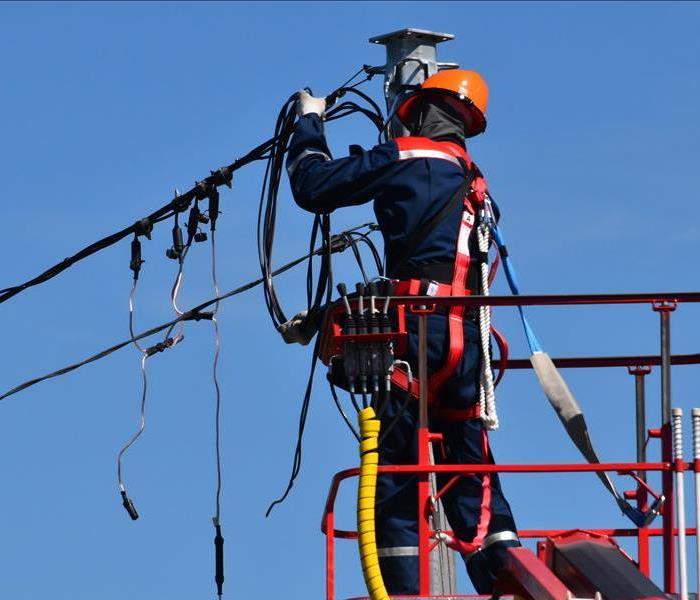 When storms hit, manual fixes are usually the only option, and that takes time. A line worker repairs a wire after a power outage.
When storms hit, manual fixes are usually the only option, and that takes time. A line worker repairs a wire after a power outage.
One thing we often take for granted is the electricity that powers everything in our home. But, when an extreme weather event occurs, you have to be prepared for power outages. A power outage can cause a myriad of problems in your home.
When a storm hits, it may cause trees to fall down, unusual wind, or other damage to your home. But most people don’t think about power outage problems that can occur when the electricity goes out and stays out for a long period.
When the power goes out, it can cause serious problems not just during the outage but when the power comes back on. For example, the food in the fridge may go bad. You will have no heat, no lights, and no way to cook meals. While this is inconvenient, when the power comes back on, you may have an even bigger problem than you’re prepared for. Here are a few reasons why.
Here are a couple of power outage problems that you might not expect.
A flooded basement
Aside from issues with your fridge, stove, and other electrical appliances not working during an outage, another important thing that doesn’t work during a power outage is your basement’s sump pump.
Sump pumps run on electricity. While your power is out, they stop working. This is not a big deal in short outages, but if it rains heavily and your sump pump isn’t working, you could end up with a lot of water in your basement. This can cause serious damage to your home. Any items that are stored in your basement may be destroyed, and the moisture can cause mold to grow even after the water has been cleaned up.
Unfortunately, sump pumps are one of those things that are easy to forget about. When you’re in the middle of a power outage, it may not even occur to check your basement for flooding. In addition to that, many people choose to stay in a hotel if their power stays out for more than a few hours. And, when they come back home they may come home to a big mess they weren’t prepared for.
Water pipes may freeze or burst
Burst pipes are an unfortunate problem during the winter months here in Michigan, and they can cause a lot of water damage to your home. This is especially true if a pipe bursts while you’re not home. When it’s cold, the heat from your home helps to keep your pipes from freezing. However, during a power outage, you lose heat, which can cause frozen pipes or a pipe that bursts.
A great preventative measure to keep them from freezing is to have a trickle of water running through the pipes. This will keep water slowly circulating through your pipes and keep them from freezing. You should also open cabinet doors to allow heat to circulate and prevent pipes from freezing.
What should you do if there is water damage after a power outage?
The first thing to do is to clean up as much of the water as you can by mopping and wiping up as much of the water as you. Move any items from your basement to a dry location if possible and then call for help.
Call SERVPRO of South and Northwest Grand Rapids today at (616) 662-9700. At SERVPRO of South and Northwest Grand Rapids, we can help you after a disaster strikes. Whether it's water damage or storm damage, we can get to your home quickly. If you do notice mold, we can help with that too. We are specialists at mold and mildew remediation and much more.
Dealing With Trees Before and After a Storm
4/6/2022 (Permalink)
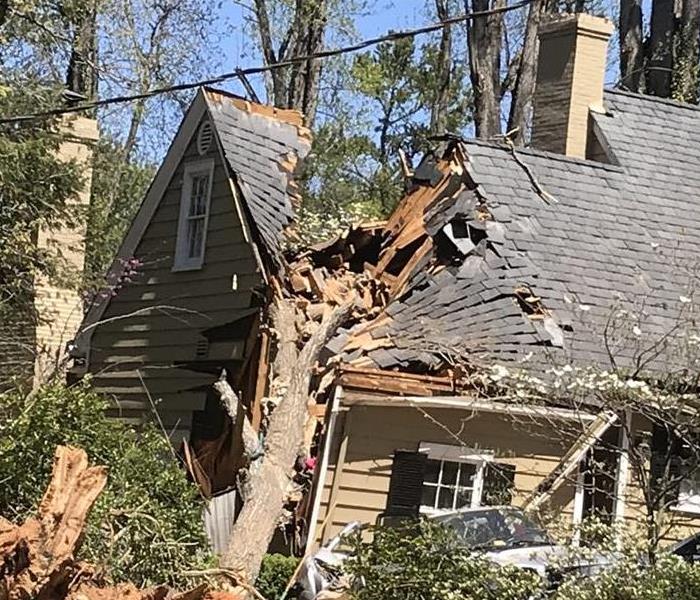 Storm Damaged Trees
Storm Damaged Trees
You know the phrase, “The bigger they are, the harder they fall”? In a literal sense, that is especially true for trees. During harsh storms, trees take a massive hit, and extreme winds can topple trees, which then cause damage to your home and property. To better protect your home, you need to start by protecting your trees.
Tree damage can cost homeowners thousands of dollars, and insurance will likely cover only a fraction of that damage. Taking the first steps to preventing that damage involves understanding the types of trees that surround your house, and the reasons why they might fall.
Unfortunately, all trees have the potential to fall over. This may be caused by wind, snow or ice, or a combination of those factors. Taller trees are more likely to get thrown down by winds, as more force is applied to the trunk with the increase in height. Also, roots can extend more than two times the radius of the branches, and not all environments allow this type of growth or development.
Also, trees with visible signs of damage or decay are even more likely to fall. If there is a tree leaning on your property, have you been able to notice an increase in its lean recently? Perhaps there are cracks in the stem. Maybe the roots are showing signs of decay. Some species of mushroom growing in the soil near trees also might indicate signs of decay.
Addressing these issues, as well as others, will help keep your tree standing. Protecting your trees also means keeping them healthy. You can help strengthen your trees by providing them with enough water and fertilizer. This becomes even more effective when you start these routines while the tree is still young.
Seasonal maintenance to your trees is essential, from the bottom to the top. Ensuring that the roots system is protected means that the tree has a solid anchor to the ground. Avoid construction or excavation around the tree and laying mulch will also help preserve nutrients and discourage weed growth.
Trimming the tree and pruning damages will not hurt the tree if done properly. In fact, with the right care you will help the tree fare much better in storms. Removing dead or weak branches ultimately boosts the growth of the tree and helps strengthen its structure. When shaping the tree correctly, it becomes more resistant to all types of weather damage.
However, once a storm passes and leaves a trail of tree damage in its wake, you will need to know a couple cleanup tips to keep the damage from getting worse. The most important thing to know is that if a tree has caused damage to power lines, you need to leave it be. In these cases, rely on the professionals to assess the severity of the damage, and allow them to repair or remove branches that put power lines in jeopardy.
Injured trees may also require the work of climbing or a chainsaw. Again, these situations need to be handled by licensed arborists, who are tree care professionals with the experience needed to remove or repair a tree.
Finally, you need to know what type of insurance coverage you have for your property, for both your home and your car. Not all insurances cover the same things, and the compensation might be different based on each circumstance.
When it comes to cleaning up the aftermath of a heavy storm, SERVPRO of South and Northwest Grand Rapids is here to help you recover as quickly as possible. For more information on protecting your home from tree damage, call SERVPRO of South and Northwest Grand Rapids today at (616) 662-9700. Our specialties include fire, water, and storm damage restoration for residential and commercial clients. We also do mold and mildew remediation and much more.
What To Do If You Experience Winter Storm Damage To Your Comstock Park Home?
1/11/2022 (Permalink)
Cold weather poses a severe challenge to Comstock Park property owners. Ice, snow, and sleet can wreak havoc on your roof, siding, driveways, and walkways, while the frequent freeze and thaw cycles can lead to frozen pipes, leaks, and other emergencies. Winter storm damage is nothing to treat lightly, and quick action in dealing with the damage is essential to protecting your home and loved ones.
At SERVPRO, we have helped many Comstock Park area homeowners deal with disasters related to winter storms. Years of managing storm restoration projects have shown us that when property owners plan and know how to handle winter storm damage quickly, it will lessen the effects of the disaster.
Whether you’re facing winter storm damage right now or you want to be ready for the worst, the following steps will help you keep disasters to a minimum and get your property back to normal.
What Are Some Common Winter Storm-Related Issues You Need To Plan For?
Comstock Park residents know that it’s always possible they may get snowed in or deal with icy, slippery surfaces, but there are many other potential emergencies caused by winter storms to think about, such as:
- Flooding. Cold snaps and freezes can damage pipes and cause them to burst, leaving you with water damage and flooded areas in your home that need emergency restoration.
- Fire. Improperly cleaned chimneys or space heaters plugged into overloaded outlets or left too near flammable objects can cause fires during a winter storm.
- Leaking Roof. Ice dams that block drainage pipes, heavy snow and ice breaking through shingles, hail, and high winds from winter storms can all be harsh on your roof, leaving your Comstock Park property exposed to moisture damage.
What Are Some Winter Storm Damage Best Practices For My Comstock Park Location?
Once a winter storm occurs, you can be left facing damages that need fixing right away; if you don’t know what to do next, the situation can feel overwhelming. To help you get quick and effective storm damage restoration for your property, call SERVPRO right away at (616) 662 9700!
While you wait for the professionals to arrive:
- Remain Calm. It will be best if you make good decisions quickly, so slow down, take a deep breath, and make careful assessments of what you’re facing.
- Safety First. When your property has suffered damage, it may put the people on the premises at risk. So you will want to ensure that family and loved ones are safe. Make sure you know where everyone is and move them out of unsafe locations. If the area is severely damaged, you may need to arrange for a temporary place for people to stay while the restoration is completed.
- Power And Water. Winter storms can often lead to leaks or floods from damaged roofs or burst pipes. Keeping the water running may worsen flooding while leaving electricity on could cause a fire. Shut off the flow to damaged areas, and call your utility companies if you need their assistance.
- Insurance. Make detailed notes and take photos of anything affected by the storm damage; this might include everything from furniture and business equipment to personal documents, valuables, and more. This step is essential for the insurance claim process. Once the storm is over and any immediate danger is gone, it’s time to reach out to your insurance company. Call your agent to get the process of filing a claim started.
Knowing what to do is essential to handling winter storm damage, and other emergency restoration needs swiftly and smoothly for your property. SERVPRO of South and Northwest Grand Rapids is here to help you should the worst happen. We will work with your insurance claims adjuster, too.
We offer many other services for your Comstock Park home in addition to storm damage, such as water damage restoration, fire and smoke damage restoration, mold remediation, and much more! Contact us for a free consultation.
This franchise is independently owned and operated.
What Are Some Smart Ways To Storm-proof My Ada Garage?
9/17/2021 (Permalink)
It is crucial to storm-proof your garage. If the garage is left unprotected, it is much more likely that there will be expensive damages even in your Ada, Michigan home itself. According to BobVila.com, "failure of the garage door ... leaves a breach in the house envelope that can be as big as 300 square feet. Experts conclude that the resulting change in pressure can blow the roof off a house or create other tears and fissures in the home that allow rains and water to invade and damage or ruin drywall."
How Can I Best Protect My Home By Storm-proofing My Ada Garage?
It is important to consistently inspect your garage door for holes and cracks and seal them when they are found. Install a bracing system to the door. Braces anchor the door to the floor, walls, and hinges, adding support and wind resistance. When it’s time to replace the garage door, look into purchasing a wind-resistant door. Install a garage door with a high wind-resistance rating. Storms that bring with them extreme levels of wind will cause the most damage, and when a garage is breached the winds will batter the rest of your home.
You can remove windows in the garage if you are concerned about heavy storms, but that may not always be an option. If you have any windows in your garage, you want to make sure the glass is impact-resistant. Installing outside window protection that can be locked and protected from impact and storm remnants is another way to provide storm protection for your garage and home.
Install a trench drain around your garage and down the sides of your driveway to divert water. Flood vents inside the garage can drain any water coming inside quickly before levels rise and cause water damage or mold growth down the line, preventing the need for mold removal.
How Can SERVPRO of South and Northwest Grand Rapids Help Me Recover From Storm Damage To My Home in Ada, MI?
If your home has experienced storm damage, we are here to help. The SERVPRO of South and Northwest Grand Rapids has the skills, training, and equipment needed to restore your property from all the destruction such an event can bring. You can count on us to handle such water damage issues as:
We can get your home or business Certified: SERVPRO Cleaned, too. This franchise is independently owned and operated.
What To Do After A Tornado
6/15/2021 (Permalink)
A tornado can pop up with little-to-no warning, and while you want to be as prepared as possible ahead of time, such an event will cause a lot of damage. Do your due diligence when it comes to preparedness, always, and let’s talk about what to do afterwards, as well, so you can be as safe as possible.
What to do after a tornado:
MAKE SURE EVERYONE IS SAFE.
Take stock of everyone who is with you, whether that is family members, friends, co-workers, fellow shoppers, even pets. See if anyone needs medical attention, and if so, can you help them using first aid, or will you need to contact emergency health professionals? If there are any children with you, make sure they are connected with parents or guardians.
ASSESS DAMAGE.
Take inventory of the damage to the building you’re in. Notice any exposed wires, broken glass, sharp objects, or chemical spills, and take precautions. Do not touch or move anything without protecting yourself with personal protective equipment. Do you smell smoke or see any sparks? Do you see any unstable fixtures, walls, roofing, or other items? Move people away from areas that are possibly dangerous if it can be done safely.
CONTACT HELP.
Call emergency personnel right away. Let them know if there is anyone who is injured, and how badly. If your building has been damaged by a tornado, describe the damage and whether anything seems to be unsafe or dangerous.
SCHEDULE RESTORATION AND RECOVERY.
Once people are safe, you can begin to consider recovery, if you are the owner or resident of the building that has been affected. A professional restoration company like SERVPRO can be onsite immediately to help you begin the restoration process. They can assess the damage, note any danger, and start to clean up the after-effects of the tornado.
When it comes to dangerous weather events, it’s good to know who’s on your side. You can always count on SERVPRO of South and Northwest Grand Rapids to help you manage when you experience a disaster of any kind. We handle fire damage, water damage, mold remediation, chemical spills, and more. We can get your home or business Certified: SERVPRO Cleaned, too. This franchise is independently owned and operated.
Preparing Your Home For A Major Storm
5/12/2021 (Permalink)
When the warmer air of Spring collides with the last of winter cold, major storms can be the result. Preparing your home for a major storm will help you and your loved ones stay safe and can prevent damages in many cases. Here are tips to help you prepare your home for a major storm:
BE PROACTIVE
Conduct an inspection of your home and yard before stormy weather hits to determine if your home has a leaky roof or windows - these can of course cause big problems during the heavy rains and strong winds of a major storm. Ensure that all your exterior doors, windows, and shutters fit correctly and are weather-stripped appropriately. Be proactive by inspecting roofing and repairing issues ahead of storms so that your home will withstand high winds.
TREES AND BUSHES
Unstable large trees and bushes will be a danger in the high winds of a major storm. To avoid severe damages to your home, trim back trees and bushes with large heavy branches so that windows and vehicles are not in danger of being destroyed by flying debris. If vegetation is unhealthy and dying, it should be removed from your property as a proactive measure.
PROPER DRAINAGE
Your property may have drainage ditches or creeks that are meant to handle excess water during storms. Take time to inspect these areas and remove debris or dirt that might obstruct the flow of water from heavy rain, since a major storm will very often cause flooding of all waterways. A clogged drainage ditch or creek bed can be the source of damage to your property during such an event. Proper drainage can be an issue in parking areas as well, so you will want to make a thorough inspection of your walkways, parking areas, and entrances to your home, garage, and any outbuildings to ensure that they can all be accessed even in the event that you experience flooding on your property.
EMERGENCY COMMUNICATION
In the case of a major storm, your cell phone service could be at risk, so you might want to consider installing a landline in case area cell phone towers are damaged or go down. Having an emergency radio and a supply of batteries on hand is another proactive way to prepare. Make sure that everyone who drives in your family knows safe routes home and that they should never drive into flowing water. Even the smallest creek can become a huge danger during a major storm that involves heavy rainfall. Establish a safe place to stay for those who may be out during bad weather in case they get caught behind floodwaters. Stock up on drinking water and foods that can be prepared without heat, and be sure to have sources of light. Those who are on regular medication need to have adequate amounts on hand as a proactive step.
The professionals here SERVPRO of South and Northwest Grand Rapids are always available in the event of damage to your home from a major storm, as well as fire damage, mold issues, biological contamination, vandalism, and more, and we are faster to disasters of any size. We can get your home or business Certified: SERVPRO Cleaned, as well - ask us how. This franchise is independently owned and operated.
What To Do After Storm Damage To Your Home
1/25/2021 (Permalink)
The very first thing you will want to do after a storm is to make sure everyone is safe. A storm can create dangerous situations both for you and for your loved ones, so you’ll want to assess your home and outside premises to see what has been affected by heavy rains and high winds.
As you check your yard, keep an eye out for debris that may be loose or hanging; branches from trees can sometimes be caught in lower branches and fall eventually - someone may be under the tree when that happens. Take stock of broken branches that will need to be removed, and if you find a tree that is down completely then you will need to contact a professional arborist to come and remove it. This type of business can take care of all your vegetation, so point out to them any issues you have found during your inspection.
If your roof has been affected by the storm this can cause you trouble in the days ahead, and you’ll only know when you have sustained water damage from the next storm. If you can safely view your roof, take the closest look that you can to see if any damage is apparent, such as gutters that have fallen, loose shingles, or even holes. If anything looks like it is wrong, connect with a professional construction company to come and handle that right away. Keep in mind that any projects you do yourself can affect your insurance claim, so be sure to educate yourself in that area.
The seals on doors and windows in your home can be affected by stormy conditions, so inspect these areas after a storm to see if they have sustained damage. You may discover that some spots will need to be re-caulked, or you may determine that it’s time for new windows if the damage to them is severe.
If you have experienced damage to your home from area storms, SERVPRO of South and Northwest Grand Rapids is here to help. We specialize in clean up and restoration projects involving water damage and fire damage, and we’re mold remediation and prevention experts, too. We can get your home or business Certified: SERVPRO Cleaned, as well; give us a call and we’ll tell you how. This franchise is independently owned and operated.
Top 3 Winter Roof Saver Tips
12/17/2020 (Permalink)
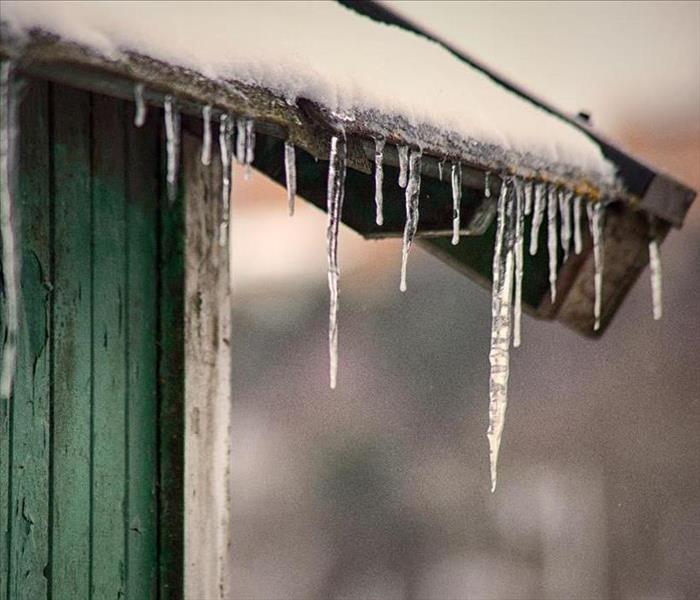 It all starts with a little snow build up and a few innocent icicles.
It all starts with a little snow build up and a few innocent icicles.
When temperatures drop and snow begins to fall, you’ll want to be confident that your roof is ready for winter weather. Your roof is one of the most important elements of your home when it comes to protecting your property from the elements all year round, and it becomes especially important in the winter.
To help you get ready for Grand Rapids snowfall, we have some tips on how to take care of your roof this winter:
Prevent and Remove Debris
Before the first significant snows ever fall, make sure to remove any fallen branches or other debris from your roof. If you see that there are tree branches hanging above your home, just know that these branches, twigs, and leaves may fall onto your roof and collect in gutters and overhangs, especially under the weight of snowfall, so a trim of trees and tall bushes may be in order. Gutters that are clogged with leaves and debris will stop melted snow from draining away properly, and you may experience water backing up into walls and attics.
Keep Snow Build Up at Bay
While snow on a roof is a lovely sight, it can actually weaken your roofing if you let it sit there too long. Snow is actually pretty heavy, depending on how much has fallen, and if your structure has any weaknesses, that weight can be a problem. It also has the potential of creating an ice dam when it melts. (An ice dam is an ice build-up on the eaves of a sloping roof that happens when melting snow under a snowpack reaches the eave and freezes there.)
Clear Your Gutters
Your gutters are one of the places where freezing precipitation will accumulate right away. They should also be checked regularly to make sure that they are not filled with leaves, branches, and other debris. One of the main causes of ice dams that we just mentioned is when gutters are clogged; they are often unable to hold the added weight when they fill up with ice and can tear away from your home, causing a lot of damage and even affecting the structure.
If you are planning on maintaining your roof yourself, please remember that climbing up on a snowy and icy roof can be dangerous. You may want to hire professional roofing contractors to clear it for you.
Our team here at SERVPRO of North and Southwest Grand Rapids is here to help you any time your home or business experiences damage from weather conditions, fire, or a mold infestation. When disaster strikes, we are there for you.
What are some of your roof saving tips?
Preparing For Fall Storms
10/6/2020 (Permalink)
Fall weather in the Grand Rapids area is beautiful, and the cooler temperatures are always welcome after the heat of summer. While you are enjoying the fall leaves, harvest decorations, and other fall-related fun, remember that stormy weather conditions are just around the corner. Whether you are a homeowner, a business owner, or both, we know you want to be prepared. Weather may be unpredictable during the fall, but you won’t have to worry about it if you prepare now.
Here are some fall storm preparation projects to consider:
While early fall is not the prime time to heavily prune back trees and bushes, it is a great time to remove any branches that are dead or look like they could become dangerous during a fall storm. If you have a tree that is dead or dying, contact an arborist to come and do a professional assessment. He or she may recommend that you have it removed before anything happens during a fall storm.
Take care of leaves and debris in your gutters and drainpipes; this will help prevent clogging during wetter weather. Clogged drains and gutters mean that rainwater will find an alternative route to the ground and it may back up into your attic or walls.
Drain all outdoor faucets ahead of freezing weather now, too.
Assess all your windows and doors for cracks; if you find issues, have them sealed now so that you can stay warm and save energy this fall and winter. You’ll be saving both time and money here!
A roof inspection ahead of colder weather will be helpful in letting you know if your roofing needs any attention before fall storms. Loose shingles can be replaced more easily when it’s done during warm and dry weather. If you have siding on your home, inspect it carefully for any loose sections. Fall storms often bring high winds that can create problems here.
Make sure your entrance walkways are in good shape, and be sure to take care of any buckling or crumbling. If earth has eroded away underneath walkways this can become a much bigger issue when heavy rains move into the area, and this can compromise the cement, causing it to crack and split. That’s an accident just waiting to happen.
If you need help preparing your home for the upcoming fall storms, call our professionals here at SERVPRO of South and Northwest Grand Rapids. We have the experience and skills necessary to take care of your property and belongings to keep them safe. We can get your home or business Certified: SERVPRO Cleaned, too!
Preventing Flooding In Your Basement
8/11/2020 (Permalink)
The best way to prevent water damage in your basement is to stay aware of the condition of this low-lying area in your home. You will want to make sure you take a look around and check for signs of potential issues regularly, and most especially after wet weather. Damage to the basement and foundation areas of a home are extremely important to repair as soon as possible in order to avoid larger structural and property damages in the future, and taking the steps to prevent flooding in the first place is imperative, and here at SERVPRO of South and Northwest Grand Rapids, we have some tips to help.
Here are some things to look for:
- Changes in the color or texture of surfaces. In a finished basement, wallpaper or paint might be peeling away or appear discolored; look for bowing in the walls, which can be a result of long-term seepage. When the basement is unfinished, you will want to keep an eye out for a white, salty substance known as “efflorescence”, which appears on foundational walls. This will tell you how high water has risen. If the basement flooring is swollen or removed from the subfloor, that is another indicator of water damages.
- Cracking can occur in the foundation and/or the floor, and it is often due to water damage. Look for cracks in window seals and door panes, as well, and if you see anything that needs attention, don’t wait for the flooding to happen to get this taken care of!
- Odors are an indicator that there is an excess water problem. Oftentimes, it’s mold or mildew that causes those smells, which means you have water damage on your hands, so any preventive measures you take are going to definitely keep your space and belongings safe from this flooding side-effect.
- Keep drainage areas well-maintained in expectation of summer storms. Directing water away from your buildings will stop any problems before they even start!
Whether you have found that you have water damage or you see that you need to take some preventive measures ahead of wetter weather, it’s time to call a professional general contractor. These companies are experienced and trained to repair and renovate spaces that have extensive damage from excess water due to leaky pipes, flooding, etc.
Our team here at SERVPRO of South and Northwest Grand Rapids is the team to call if you need help in taking steps to prevent flooding in your basement, as well as for cleanups after water damage or fire damage, whether small or large. We are also mold-remediation experts, restoration specialists, and skilled in large scale commercial cleaning projects, and more.
How Often Should You Be Cleaning Your Gutters?
6/2/2020 (Permalink)
Rain gutters that are clogged with debris from storms, high winds, or falling leaves during the Fall season are often the cause of water damage to your home or business. If you are wondering how often you should be cleaning your gutters, the answer to that can be found in thinking about the seasons. If you know we are heading into a season that may involve falling leaves, flying debris, or heavy downpours, that is the perfect time to schedule a rain gutter cleaning. A good rule of thumb would probably be to make sure your gutters are in good shape at least four times a year, as each new season is starting. That way you will always be ready for whatever comes.
This task is actually a fairly simple one that you can do yourself, but if you are not comfortable on a ladder or if the areas you need to reach are not easily accessible, it may be time to call a professional service in Grand Rapids, MI to help you with the cleaning and the unclogging of your gutters, and that will protect you from having to deal with water-related damages.
If you do decide to do the job on your own, make sure you stay safe. You will want to use step ladders on solid level ground and try to complete cleaning when the weather has been dry for a few days. If you do this, you can be confident that the debris, leaves, and pine needles will be much easier to remove. Once the larger debris is gone, follow that up with a powerful hose that is able to wash the residuals down the downspout. You will also want to clean the gutter filter screens and make sure there are no clogs in your downspout. Above all safety is key.
Contact us here at SERVPRO of South and Northwest Grand Rapids if your home or business experiences any water damage due to overflowing rain gutters, as well as damage from storms and floods. We are mold prevention and remediation experts, too. We are proud to serve our Grand Rapids neighbors!
Storms Come Unexpectedly; prepare now
5/29/2020 (Permalink)
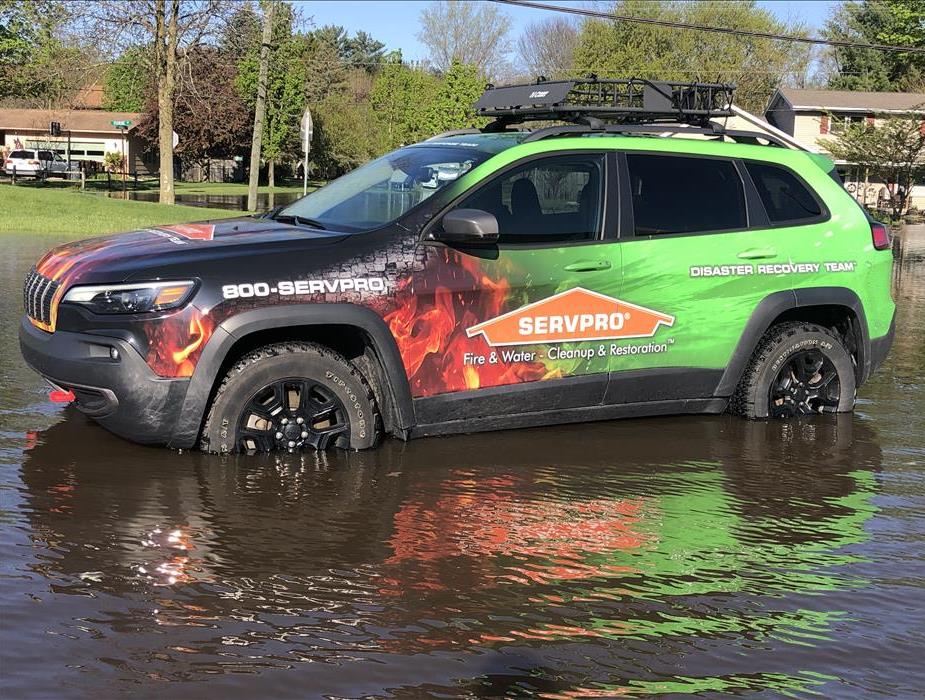 Most of the streets in this town were completely flooded. SERVPRO answered the call for help.
Most of the streets in this town were completely flooded. SERVPRO answered the call for help.
The dam failures not too far from us in Grand Rapids, MI serve as a harsh reminder that nature is an unpredictable force to be reckoned with. Tornado outbreaks, river floods, flash floods, historic earthquakes, and even water main breaks and power outages in U.S. cities are more examples that affect millions of people for days at a time.
Now is the time to think about the basics, things you will need in advance of an emergency: how you will communicate, what supplies you will need to keep in your home, car or office. Use the list provided here to build an emergency supply kit to ensure your family is equipped and ready for any type of disaster.
The more you know about what to do in an emergency, the more confident and secure you will feel in your abilities to manage through a disaster.
Preparation is the key to making it through any size disaster, whether it is a small water leak, a large fire, or an area flood. The best time to plan for such events is not when the event happens, but well before it happens. No one plans on a disaster, but now, you can plan for it.
Build An Emergency Supply Kit:
- Water, gallon per person per day
- Food, non-perishable 3-day supply
- Manual can opener
- Battery operated radio and extra batteries
- Flashlight and extra batteries
- First aid kit
- Whistle to signal for help
- Wrench or pliers to turn off utilities, if necessary
- Dust masks or bandannas
- Plastic sheeting, garbage bags and duct tape
- Local maps
- Hygiene items
- Clothing
- Fire extinguisher
- Matches in waterproof container
- Cash
- Important documents such as:
- Copies of insurance
- Policies, identification and
- Bank account information
Contact your local professionals at SERVPRO of South and Northwest Grand Rapids for more information and tools to help you be “Ready for whatever happens.”
How To Storm-Proof Your Garage
3/24/2020 (Permalink)
It is vital to the safety of your entire home to stormproof your garage adequately. Completing this project will protect both your family and your home from heavy weather damages, such as high winds and flooding. If your garage is left unprotected, it is much more likely that there will be expensive damages from an event of this kind. Here are just a few tips to help you get started on storm-proofing the garage:
- Garage Door. The door of your garage is going to be susceptible to damage, so your storm-proofing project should begin with ensuring you have a sturdy door. It is also important to regularly check your garage door for holes and cracks, and seal any that occur so that your garage will stay protected. We recommend installing a bracing system to the door; braces anchor the door to the floor, walls, and hinges, adding support and wind resistance. This can be done yourself or you can hire a professional.
- Windows. You may want to remove windows in your garage if storms are expected in your area, but that may not always be an option. When purchasing windows for your garage, you can install windows with impact-resistant glass, as well as exterior window protection that can be closed and locked to protect the interior from impact and storm remnants.
- Drainage. Water damage can always negatively impact your garage through flooding, potentially causing mold and health problems. You can install a trench drain outside your garage to prevent this occurrence. This drain will create a channel for water to flow through and avoid the overflow of water in gutters and low-lying areas on your property. You may also install flood vents, which allow water to flow through your garage easily, alleviating pressure on your foundation.
If you are concerned about your garage and need assistance in this area of your home, our team of highly trained professionals here at SERVPRO of Northwest/South Grand Rapids is always ready to help. We are water damage and fire damage professionals, and mold cleanup and remediation experts, too.
Storm-Proofing Your Basement
1/14/2020 (Permalink)
Water-proofing your basement will be the best way to storm-proof it, since most storms involve lots of water. You will be able to avoid a wet basement that encourages mold growth, which is another nightmare you don’t need. During a storm, water can leak through roofs and pipes and affect foundations, too, and flooded foundations will almost inevitably affect your basement.
Here are a few ways you can both water- and storm-proof your basement:
If you experience flooding or wet conditions after a heavy storm, your trouble can almost certainly be traced to your drainage conditions around the outside of your home. If too much water has collected around the foundation in the soil it will leak into your basement through the walls. The solution here will be to improve your drainage conditions ahead of more storms.
- Roof Drainage. This is the number one cause of basement leakage. Make sure your gutters have at least one downspout for every 600 to 800 square feet of roof surface for proper drainage. Keep them clean so that water doesn’t collect and overflow down to your foundations. Ensure that the ends of the downspouts are extended so that they direct water at least 4 to 6 feet away from the foundation, protecting your basement from storm damage. If your local building laws permit you to, you can direct this water into the street or another low-lying area.
- Sloping Soil. The angle of your soil around your home’s foundation can also cause wet basement issues after a storm. Your soil should slope away from the home to keep rainfall from collecting there. If your grading needs improvement, use clean fill dirt to build up soil around your house, and tamp it down to the correct slope. Finish with a topsoil layer and grass seed to prevent erosion, further storm-proofing your basement.
- Landscaping. Avoid landscaping that holds soil close to the house. It may look great but those brick or stone edgings can prevent water from draining away and increase your basement flooding risk.
These water- and storm-proofing measures will help prevent many of your wet basement situations, keeping you safe from all the unpleasant side effects of damp. If you experience a large flooding event or need help drying out a wet basement after a storm, the team here at SERVPRO of Northwest/South Grand Rapids is ready to help at a moment’s notice. We are mold remediation experts, too!
Wind Storms are here, are you ready? SERVPRO is!
11/27/2019 (Permalink)
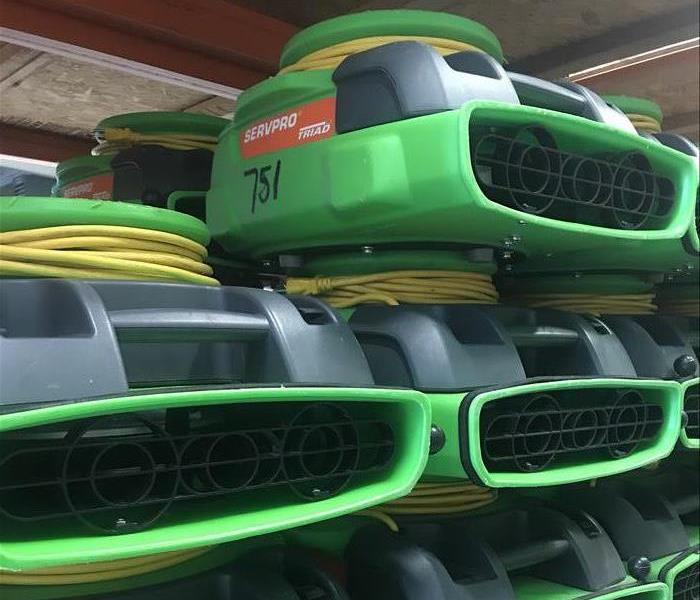 SERVPRO's state-of-the-art equipment
SERVPRO's state-of-the-art equipment
SERVPRO of South and Northwest Grand Rapids specializes in storm and flood damage restoration. Our crews are highly trained and use specialized equipment to restore your property to its pre-storm condition.
Faster Response
Since we are locally owned and operated, we are able to respond quickly with the right resources, which is extremely important. A fast response lessens the damage, limits further damage, and reduces the restoration cost.
Resources to Handle Floods and Storms
When storms hit the greater Grand Rapids area, we can scale our resources to handle a large storm or flooding disaster. We can access equipment and personnel from a network of over 1,700 Locations across the country and elite Disaster Recovery Teams that are strategically located throughout the United States.
Have Storm or Flood Damage? Call Us Today 616-662-9700
Preparing Your Yard/Property For Storm Damage
11/5/2019 (Permalink)
Here at SERVPRO of South and North West Grand Rapids, we advise homeowners to prepare their homes and property for the coming winter storm season. Extreme weather can lead to power outages and disruption of communications, as well as damaging personal and business property and belongings. Flooding and large snow accumulations can cause travel to become extremely dangerous and even deadly, so it’s important to be prepared for many different serious situations to occur during winter here in Michigan.
Here are some essential safety tips to help you prepare your home for the coming winter season:
- Exterior Doors/Windows. These areas need to be inspected and sealed properly or replaced ahead of storms and other winter weather conditions. Not only will you stay safer, but you will save on related energy costs, especially if you replace old windows and doors with newer, more efficient models. There are many different types and styles to choose from.
- Gutters. When snow melts, it needs to be able to flow down your rain gutters and away from your roofing. If there is dirt and debris left in your gutters from last spring, the water will pool and begin to back up, possibly damaging even interior wall spaces in your home, and this can even lead to mold growth, causing a need for mold removal on top of the storm damage. A rain gutter that is full of dirt can become heavy and can pull away from the building, creating another set of issues.
- Landscaping. Before storm season comes, make sure all dead or unhealthy trees and bushes are trimmed back or removed. Cut away branches that are not stable, and clean up those items that may be littering your premises. Flying tree branches and other debris can cause major damages to your property when a storm hits.
Our team here at SERVPRO of Grand Rapids cares about your safety and the safety of your loved ones and your property. If you need help after an extreme weather event, call us. We are water damage and fire damage experts, and we specialize in mold remediation.
How To Prevent Storm Damage To Your Business
8/27/2019 (Permalink)
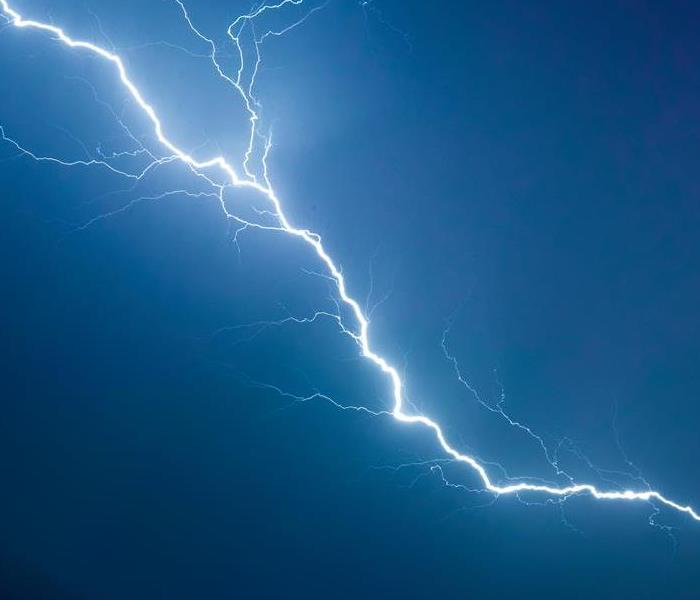 Lightning strikes during thunderstorms can cause significant damage to your home and property.
Lightning strikes during thunderstorms can cause significant damage to your home and property.
Falling trees, fire, high wind and hail storms often cause damage to roofing and other vulnerable parts of your property. Safety should always be your primary concern to prevent storm damage to your business.
- Roofing. The best way to prevent unnecessary damages is to ensure that your roof is in the best shape possible before storm season hits. After a storm, any initial roof assessment should be completed from the ground as you want to make sure you are safe. If you suspect damage to your shingles or structure, contact a professional immediately. Make sure everyone vacates the premises in the event of major roof damage.
- Landscaping. Before the stormy season, have your landscaping trimmed back and remove all dead or dying vegetation. This will help to lessen the risk of flying branches or falling trees.
- Parking Areas. Keeping your parking areas in good repair will mean that after a storm, your clients will still be able to get to you. Potholes and flooding in your parking lot will keep everyone away, including your workforce.
- Walkways. Heavy storms can undercut walkways, making them dangerous for pedestrians, and that’s something you definitely want to avoid. Have them updated and strengthened before heavy weather, and take a good look at them after a storm moves through the area. If you need a second pair of eyes, call a professional storm damage cleanup company for help.
Storms and inclement weather can bring wind damage, heavy rain, and flooding that can devastate any business in a matter of minutes. There’s never a convenient time for flooding or water damage to strike, and storms don’t just strike during regular business hours; that’s why SERVPRO Franchise Professionals offer 24-hour emergency service 365 days of the year.
The SERVPRO Disaster Recovery Team can provide help whether your property has experienced a tornado, hurricane, blizzard or flood. The SERVPRO System has a network of strategically positioned storm teams on standby should a disaster strike near you. Here at SERVPRO of South and North West Grand Rapids, we are always prepared for the unpredictable.
Five Steps to Storm-Proofing Your Garage
5/7/2019 (Permalink)
 Make sure to equip your garage to prevent storm damage!
Make sure to equip your garage to prevent storm damage!
Make storm-proofing your attached garage a priority when planning to protect your home from storms. Being one of the largest spaces in any home, your garage is also the most vulnerable place when it comes to high winds. Here are some tips to storm-proof your garage, which will also protect the rest of your home:
- High Impact Ratings. Storms with extreme wind will cause the most damage; when a garage is breached, the rest of your home is at risk. Water can come in, and even just an inch of water can cause expensive and unwanted damage. If you live in an area prone to tornadoes, it is recommended that you invest in a door that can withstand winds of 130 mph or higher. Doors with high impact-ratings will protect your home and belongings from flying debris.
- Bracing system. You can reinforce your garage door with a proper bracing system. Most garage doors are secured only by the tracks or hinges, which will be of no benefit during a powerful storm. A bracing system works by anchoring the door to the walls and floors and into each hinge.
- Maintenance. If there are any holes, cracks, or breaches in your garage door, that will allow storm winds through. Perform a monthly inspection looking for these types of issues as well as problems with the weather stripping or any parts of the garage door mechanisms and functionality to ensure that any repairs are performed as soon as possible.
- Secure all windows. If you have windows in your attached garage, these are considered weak points during extreme weather. Ensure they are in good repair and the weather stripping is strong at all times. Having wrought-iron window protection installed can also be a protective addition to keep your glass safe from flying debris.
- Install drainage and flood vents. Make sure that your entire home is properly outfitted for the drainage of large amounts of water. You can have a trench drain installed around your home and on the sides of your driveway to divert water, and flood vents inside the garage can quickly drain any water coming inside before levels rise and cause damage.
Here at SERVPRO of South and North West Grand Rapids, we are always ready to help you if you experience water or fire damages; whether at home or in a commercial setting. Contact us today by phone at (616) 662-9700, or visit us on our website.
Do you have an Emergency Communication Plan for when disaster strikes?
5/2/2018 (Permalink)
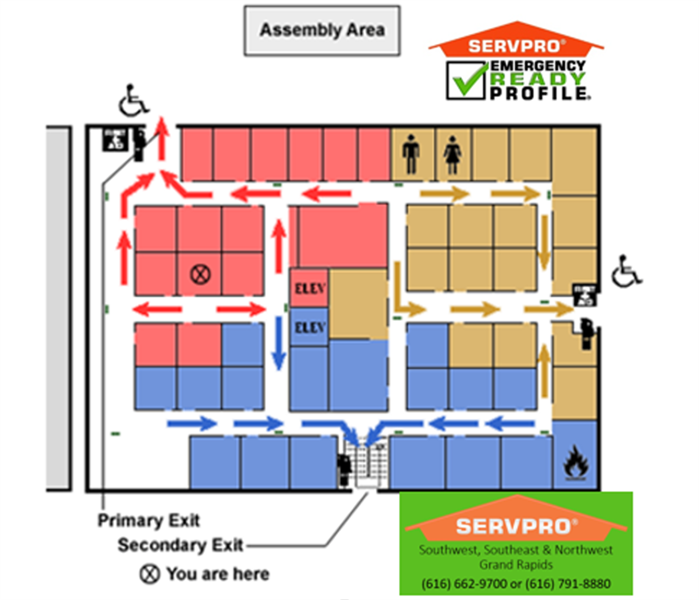 Is your plan in place?
Is your plan in place?
The following explains what an emergency communication plan is and why you should make one. It also provides tips and templates on how to make a plan. The following information is from ready.gov.
Your family may not be together if a disaster strikes, so it is important to think about the following situations and plan just in case. Consider the following questions when making a plan:
- How will my family/household get emergency alerts and warnings?
- How will my family/household get to safe locations for relevant emergencies?
- How will my family/household get in touch if cell phone, internet, or landline doesn’t work?
- How will I let loved ones know I am safe?
- How will family/household get to a meeting place after the emergency?
Here are a few easy steps to start your emergency communication plan:
- Understand how to receive emergency alerts and warnings. Make sure all household members are able to get alerts about an emergency from local officials. Check with your local emergency management agency to see what is available in your area, and learn more about alerts by visiting: ready.gov/alerts.
- Discuss family/household plans for disasters that may affect your area and plan where to go. Plan together in advance so that everyone in the household understands where to go during a different type of disaster like a hurricane, tornado, or wildfire.
- Collect information. Create a paper copy of the contact information for your family that includes:
- phone (work, cell, office)
- email
- social media
- medical facilities, doctors, service providers
- school
- Identify information and pick an emergency meeting place. Things to consider:
- Decide on safe, familiar places where your family can go for protection or to reunite.
- Make sure these locations are accessible for household members with disabilities or access and functional needs.
- If you have pets or service animals, think about animal-friendly locations.
Examples of meeting places:
- In your neighborhood: A mailbox at the end of the driveway, or a neighbor’s house.
- Outside of your neighborhood: library, community center, place of worship, or family friend’s home.
- Outside of your town or city: home of a relative or family friend. Make sure everyone knows the address of the meeting place and discuss ways you would get there.
- Share information. Make sure everyone carries a copy in his or her backpack, purse, or wallet. You should also post a copy in a central location in your home, such as your refrigerator or family bulletin board.
- Practice your plan.Have regular household meetings to review your emergency plans, communication plans and meeting place after a disaster, and then practice, just like you would a fire drill.
Source ready.gov
When disaster hits your property and you need restoration services due to Storm Damage, Call SERVPRO® of Southwest Grand Rapids at 616-662-9700 24/7 emergency services available.
MAY IS NATIONAL BUILDING SAFETY MONTH
5/1/2018 (Permalink)
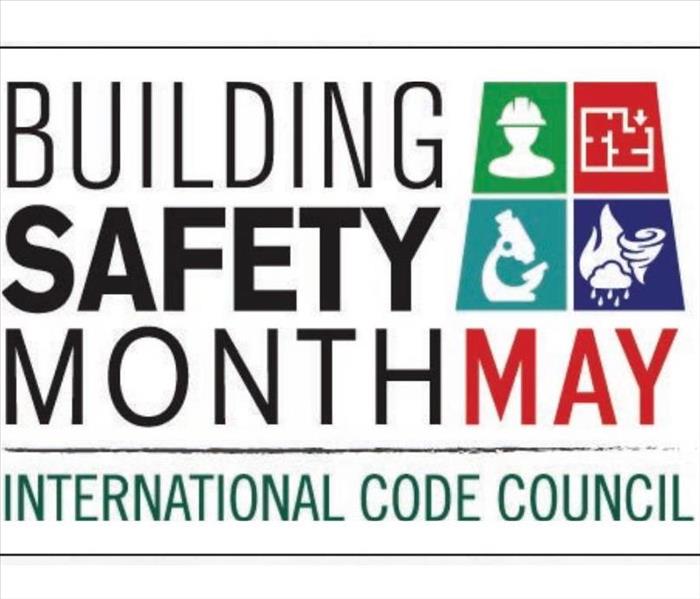 Building codes provide you, your family and your community protection in the event of a natural disaster.
Building codes provide you, your family and your community protection in the event of a natural disaster.
Building Safety Month, in its 38th year, is an initiative of the International Code Council (ICC) and their 64,000 members across the world, as well as their partners in building construction and design and the safety community. Building Safety Month is an opportunity to educate insurance and commercial property professionals, as well as the general public, on “what it takes to create safe, resilient, affordable, and energy efficient homes and buildings,” according to the ICC website.
The theme for 2018 is Building Codes Save Lives with a focus on safer communities over the five weeks in May.
One of the topics highlighted during the third week of the month is Protecting Communities from Disasters.
The general public may not be aware how codes and code officials “improve and protect the places where we live, learn, work, worship, and play,” and this month can certainly improve that awareness and educate communities on this topic!
IMPORTANT TIPS FROM THE ICC
Disaster Safety & Mitigation
- If you live in a high wind or hurricane-prone area and do not have tested and code-approved shutters for protection from windborne debris, consider temporarily protecting your doors and windows by mounting exterior grade, 7/16" minimum thickness plywood and fastening it into place. Visit www.flash.org for detailed instructions on how to use plywood for emergency board-up.
- Consider building or retrofitting to create a tornado-safe room in your home. Follow ICC/ NSSA 500 Standard for detailed construction information and to ensure you achieve the highest level of protection for your family.
- In wildfire prone areas, remove fine (dead grass, leaves, etc.) and coarse (dead twigs, branches, etc.) fuels within 30 feet of a building to create a survivable space in case of wildfire. Be sure to remove dry leaf and pine litter from roofs, rain gutters, decks, and walkways. Follow ICC’s International Wildland-Urban Interface Code® for detailed requirements.
- Flooded roads could have significant damage hidden by floodwaters. Never drive through floodwaters or on flooded roads. Do not attempt to cross a flowing stream. It takes only six inches of fast flowing water to sweep you off your feet and two feet of water to move an SUV-sized vehicle.
Source: iccsafe.org
If a disaster hits your home Contact SERVPRO® of Southwest Grand Rapids at 616-662-9700, available 24/7 for emergency services.
When Tornadoes cause damage to your Southwest Grand Rapids property
5/1/2018 (Permalink)
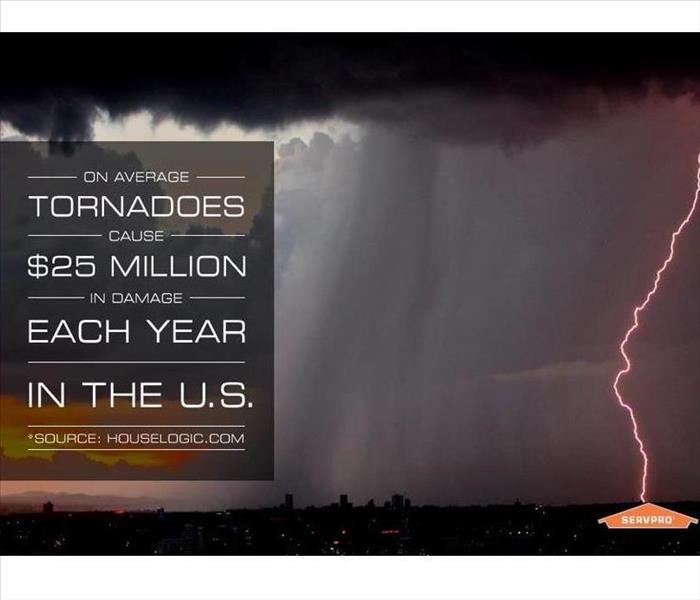 Tornadoes happen when we least expect them, do you know what to do when then occur?
Tornadoes happen when we least expect them, do you know what to do when then occur?
Tornadoes are nature’s most violent storms. Spawned from powerful thunderstorms, tornadoes can cause fatalities and devastate a neighborhood in seconds. A tornado appears as a rotating, funnel-shaped cloud that extends from a thunderstorm to the ground with whirling winds that can reach 300 miles per hour. Damage paths can be in excess of one mile wide and 50 miles long. Every state is at some risk from this hazard. Some tornadoes are clearly visible, while rain or nearby low-hanging clouds obscure others. Occasionally, tornadoes develop so rapidly that little, if any, advance warning is possible. Before a tornado hits, the wind may die down and the air may become very still. A cloud of debris can mark the location of a tornado even if a funnel is not visible. Tornadoes generally occur near the trailing edge of a thunderstorm. It is not uncommon to see clear, sunlit skies behind a tornado
After A Tornado
- Listen to local officials for updates and instructions.
- Check-in with family and friends by texting or using social media.
- Watch out for debris and downed power lines.
- If you are trapped, do not move about or kick up dust. Tap on a pipe or wall or use a whistle, if you have one, so that rescuers can locate you.
- Stay out of damaged buildings and homes until local authorities indicate it is safe.
- Photograph the damage to your property in order to assist in filing an insurance claim.
- Do what you can to prevent further damage to your property, (e.g., putting a tarp on a damaged roof), as insurance may not cover additional damage that occurs after the storm.
- If your home is without power, use flashlights or battery-powered lanterns rather than candles to prevent accidental fires.
Source ready.gov
If a Tornado should hit your property and you need restoration services due to Storm Damage, Call SERVPRO® of Southwest Grand Rapids at 616-662-9700 24/7 emergency services available.
Southwest Grand Rapids Leave the Hassle of Board-Ups to the Professionals
4/26/2018 (Permalink)
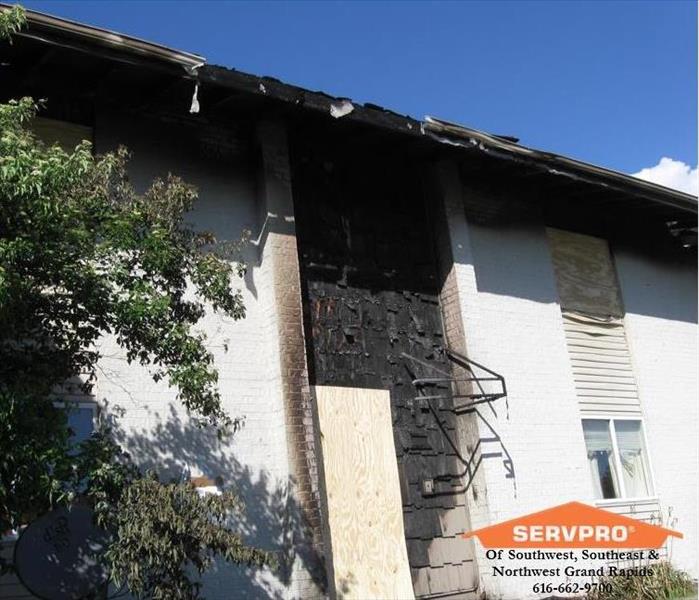 Let us do the work!
Let us do the work!
Why take the risk? Call SERVPRO® of Southwest Grand Rapids.
Whether after a fire, storm, or other structural disaster, boarding up damaged property is a burden that no one should ever have to go through—especially if it is your property that has been damaged.
Boarding up damaged property incorrectly could cause secondary damages such as moisture or animal intrusion, making the situation even worse. The process of boarding up after an unexpected damage can also be as dangerous as the damage itself.
SERVPRO® of Southwest Grand Rapids can board up the damaged property and mitigate and remediate the original damage, providing you with peace of mind while helping make it
“Like it never even happened.” Contact us at 616-662-9700 for 24/7 emergency service.
How to prepare for a Thunderstorm in Southwest Grand Rapids
4/26/2018 (Permalink)
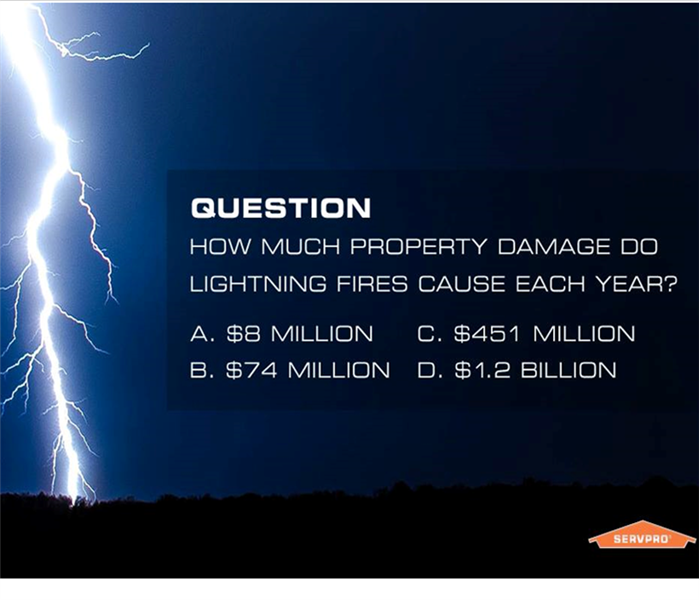 Lightning Fires cause about $451 Million in property damage each year.
Lightning Fires cause about $451 Million in property damage each year.
Southwest Grand Rapids, Is your family prepared for a Thunderstorm?
To prepare for a thunderstorm, you should do the following:
- To begin preparing, you should build an emergency kit and make a family communications plan.
- Remove dead or rotting trees and branches that could fall and cause injury or damage during a severe thunderstorm.
- Postpone outdoor activities.
- Secure outdoor objects that could blow away or cause damage.
- Get inside a home, building, or hard top automobile (not a convertible). Although you may be injured if lightning strikes your car, you are much safer inside a vehicle than outside.
- Remember, rubber-soled shoes and rubber tires provide NO protection from lightning. However, the steel frame of a hard-topped vehicle provides increased protection if you are not touching metal.
- Shutter windows and secure outside doors. If shutters are not available, close window blinds, shades or curtains.
- Unplug any electronic equipment well before the storm arrives.
Lightning Risk Reduction When Outdoors
If you are: In a forest
Then: Seek shelter in a low area under a thick growth of small trees.
If you are: In an open area
Then: Go to a low place such as a ravine or valley. Be alert for flash floods.
If you are: On open water
Then: Get to land and find shelter immediately.
Facts about Thunderstorms
- They may occur singly, in clusters or in lines.
- Some of the most severe occur when a single thunderstorm affects one location for an extended time.
- Thunderstorms typically produce heavy rain for a brief period, anywhere from 30 minutes to an hour.
- Warm, humid conditions are highly favorable for thunderstorm development.
- About 10 percent of thunderstorms are classified as severe – one that produces hail at least an inch or larger in diameter, has winds of 58 miles per hour or higher or produces a tornado.
Facts about Lightning
- Lightning’s unpredictability increases the risk to individuals and property.
- Lightning often strikes outside of heavy rain and may occur as far as 10 miles away from any rainfall.
- “Heat lightning” is actually lightning from a thunderstorm too far away from thunder to be heard. However, the storm may be moving in your direction.
- Most lightning deaths and injuries occur when people are caught outdoors in the summer months during the afternoon and evening.
- Your chances of being struck by lightning are estimated to be 1 in 600,000 but could be reduced even further by following safety precautions.
- Lightning strike victims carry no electrical charge and should be attended to immediately.
Know the Terms
Familiarize yourself with these terms to help identify a thunderstorm hazard:
Severe Thunderstorm Watch- Tells you when and where severe thunderstorms are likely to occur. Watch the sky and stay tuned to NOAA Weather Radio, commercial radio or television for information.
Severe Thunderstorm Warning- Issued when severe weather has been reported by spotters or indicated by radar. Warnings indicate imminent danger to life and property to those in the path of the storm.
Source ready.gov
If a Thunderstorm should hit your property and you need restoration services due to Storm Damage, Call SERVPRO® of Southwest Grand Rapids at 616-662-9700 24/7 emergency services available.
Sump Pump Failure during storm
3/30/2018 (Permalink)
 How to a sump pump works
How to a sump pump works
When the ground is dry and then gets an influx of water to saturate the ground, where does the water go? Once the water has flooded the surrounding grounds, the water searches for the weakest point to enter any hard surfaces. Many times that is your basement floor. Which is why we have sump pumps.
How it works - A hole is dug in the lowest part of your basement or crawlspace where a sump pump sits and filters out water. As the pit fills up, the pump turns on and moves the liquid out of the pit through pipes that run away from the foundation of your home into an area where it can drain, such as a municipal storm drain or a dry well. A one-way valve (check valve) keeps water from entering back into the home.
Why does it fail?
- Power Failure
- Pump is the wrong Size
- Improper Installation
- Switch Problems on the pump
- Lack of Maintenance
- Frozen or Clogged Discharge Lines
- Product Default
- Passed Life Expectancy
How can you prevent failure? Quarterly maintenance.
When there’s an influx of ground water or your power goes out, keep an eye on your pump to make sure you don’t become a victim of a flooded area in your home.
Another important point is the sump pump's power supply. The fact that sump pumps rely on electricity to operate does make them vulnerable in the event of a power outage. Fortunately, there are backup options available. For some people, at least those on municipal water systems -- and assuming the city water system is still functional -- water-powered sump pumps that don't need any electricity are an option. These pumps literally use the pressure of flowing water to pump water out of the sump. The downside to this design is that the pumping process uses virtually the same amount of city water as the quantity of water it pumps out. So, while water-powered pumps aren't necessarily a good choice for a main pump, they offer a viable option for a short duration backup pump.
SERVPRO® of Southwest Grand Rapids is here to help. We are available 24/7 for emergency services. Call us at 616-662-9700
Insert pic Sump pump C:\Users\Sales1\Documents\Sales\Web stages\Blog Pics
Be prepared for Natural Disasters
3/5/2018 (Permalink)
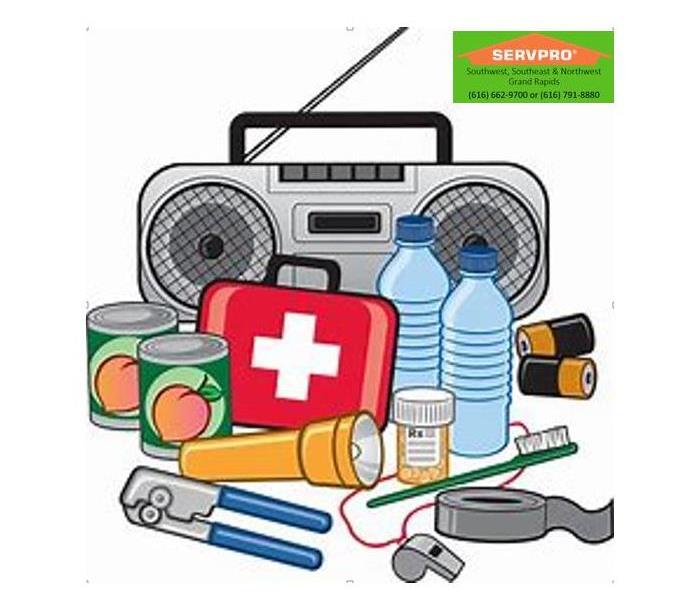 Have a kit and plan together for when the big storm hits!
Have a kit and plan together for when the big storm hits!
Don’t wait to prepare!! Emergencies can happen unexpectedly in communities just like yours, to people just like you. Tornado outbreaks, river floods, flash floods, historic earthquakes, and even water main breaks and power outages in U.S. cities affecting millions of people for days at a time.
Now is the time to think about the basics, things you will need in advance of an emergency; how you will communicate, what supplies you will need to keep in your home, car or office. Use the list provided here to build an emergency supply kit to ensure your family is equipped and ready for any type of disaster.
The more you know about what to do in an emergency, the more confident and secure you will feel in your abilities to manage through a disaster.
Preparation is the key to making it through any size disaster, whether it is a small water leak, a large fire, or an area flood. The best time to plan for such events is not when the event happens, but well before it happens. No one ever plans on a disaster, but now, you can plan for it.
Build An Emergency Supply Kit:
- Water, gallon per person per day
- Food, non-perishable 3-day supply
- Manual can opener
- Battery operated radio and extra batteries
- Flashlight and extra batteries
- First aid kit
- Whistle to signal for help
- Wrench or pliers to turn off utilities, if necessary
- Dust masks or bandanas
- Plastic sheeting, garbage bags and duct tape
- Local maps
- Hygiene items
- Clothing
- Fire extinguisher
- Matches in waterproof container
- Cash
- Important documents such as:
- Copies of insurance
- Policies, identification and
- Bank account information
Contact SERVPRO® Southwest Grand Rapids Professionals for more information and tools to help you be “Ready for whatever happens.”
Southwest Grand Rapids, Are you prepared for Thunderstorms?
5/8/2017 (Permalink)
Southwest Grand Rapids, To prepare for a thunderstorm, you should do the following:
- To begin preparing, you should build an emergency kit and make a family communications plan.
- Remove dead or rotting trees and branches that could fall and cause injury or damage during a severe thunderstorm.
- Postpone outdoor activities.
- Secure outdoor objects that could blow away or cause damage.
- Get inside a home, building, or hard top automobile (not a convertible). Although you may be injured if lightning strikes your car, you are much safer inside a vehicle than outside.
- Remember, rubber-soled shoes and rubber tires provide NO protection from lightning. However, the steel frame of a hard-topped vehicle provides increased protection if you are not touching metal.
- Shutter windows and secure outside doors. If shutters are not available, close window blinds, shades or curtains.
- Unplug any electronic equipment well before the storm arrives.
Lightning Risk Reduction When Outdoors
If you are:
- In a forest; Seek shelter in a low area under a thick growth of small trees.
- In an open area; Go to a low place such as a ravine or valley. Be alert for flash floods.
- On open water; Get to land and find shelter immediately.
Facts about Thunderstorms
- They may occur singly, in clusters or in lines.
- Some of the most severe occur when a single thunderstorm affects one location for an extended time.
- Thunderstorms typically produce heavy rain for a brief period, anywhere from 30 minutes to an hour.
- Warm, humid conditions are highly favorable for thunderstorm development.
- About 10 percent of thunderstorms are classified as severe – one that produces hail at least an inch or larger in diameter, has winds of 58 miles per hour or higher or produces a tornado.
Facts about Lightning
- Lightning’s unpredictability increases the risk to individuals and property.
- Lightning often strikes outside of heavy rain and may occur as far as 10 miles away from any rainfall.
- “Heat lightning” is actually lightning from a thunderstorm too far away from thunder to be heard. However, the storm may be moving in your direction.
- Most lightning deaths and injuries occur when people are caught outdoors in the summer months during the afternoon and evening.
- Your chances of being struck by lightning are estimated to be 1 in 600,000 but could be reduced even further by following safety precautions.
- Lightning strike victims carry no electrical charge and should be attended to immediately.
Know the Terms
Familiarize yourself with these terms to help identify a thunderstorm hazard:
Severe Thunderstorm Watch - Tells you when and where severe thunderstorms are likely to occur. Watch the sky and stay tuned to NOAA Weather Radio, commercial radio or television for information.
Severe Thunderstorm Warning - Issued when severe weather has been reported by spotters or indicated by radar. Warnings indicate imminent danger to life and property to those in the path of the storm.
Source ready.gov
If a Thunderstorm should hit your property and you need restoration services due to Storm Damage, Call SERVPRO of Southwest Grand Rapids at 616-662-9700 24/7 emergency services available.
When Tornadoes cause damage to your Southwest Grand Rapids property
5/8/2017 (Permalink)
Tornadoes are nature’s most violent storms. Spawned from powerful thunderstorms, tornadoes can cause fatalities and devastate a neighborhood in seconds. A tornado appears as a rotating, funnel-shaped cloud that extends from a thunderstorm to the ground with whirling winds that can reach 300 miles per hour. Damage paths can be in excess of one mile wide and 50 miles long. Every state is at some risk from this hazard. Some tornadoes are clearly visible, while rain or nearby low-hanging clouds obscure others. Occasionally, tornadoes develop so rapidly that little, if any, advance warning is possible. Before a tornado hits, the wind may die down and the air may become very still. A cloud of debris can mark the location of a tornado even if a funnel is not visible. Tornadoes generally occur near the trailing edge of a thunderstorm. It is not uncommon to see clear, sunlit skies behind a tornado
After A Tornado
- Listen to local officials for updates and instructions.
- Check-in with family and friends by texting or using social media.
- Watch out for debris and downed power lines.
- If you are trapped, do not move about or kick up dust. Tap on a pipe or wall or use a whistle, if you have one, so that rescuers can locate you.
- Stay out of damaged buildings and homes until local authorities indicate it is safe.
- Photograph the damage to your property in order to assist in filing an insurance claim.
- Do what you can to prevent further damage to your property, (e.g., putting a tarp on a damaged roof), as insurance may not cover additional damage that occurs after the storm.
- If your home is without power, use flashlights or battery-powered lanterns rather than candles to prevent accidental fires.
Source ready.gov
If a Tornado should hit your property and you need restoration services due to Storm Damage, Call SERVPRO of Southwest Grand Rapids at 616-662-9700 24/7 emergency services available.
Do you have an Emergency Communication Plan for when disaster strikes?
5/8/2017 (Permalink)
This page explains what an emergency communication plan is and why you should make one. It also provides tips and templates on how to make a plan. The following information is from ready.gov.
Why Make A Plan
Your family may not be together if a disaster strikes, so it is important to think about the following situations and plan just in case. Consider the following questions when making a plan:
- How will my family/household get emergency alerts and warnings?
- How will my family/household get to safe locations for relevant emergencies?
- How will my family/household get in touch if cell phone, internet, or landline doesn’t work?
- How will I let loved ones know I am safe?
- How will family/household get to a meeting place after the emergency?
Here are a few easy steps to start your emergency communication plan:
- Understand how to receive emergency alerts and warnings. Make sure all household members are able to get alerts about an emergency from local officials. Check with your local emergency management agency to see what is available in your area, and learn more about alerts by visiting: ready.gov/alerts.
- Discuss family/household plans for disasters that may affect your area and plan where to go.Plan together in advance so that everyone in the household understands where to go during a different type of disaster like a hurricane, tornado, or wildfire.
- Collect information.Create a paper copy of the contact information for your family that includes:
- phone (work, cell, office)
- email
- social media
- medical facilities, doctors, service providers
- school
- Identify information and pick an emergency meeting place. Things to consider:
- Decide on safe, familiar places where your family can go for protection or to reunite.
- Make sure these locations are accessible for household members with disabilities or access and functional needs.
- If you have pets or service animals, think about animal-friendly locations.
Examples of meeting places:
- In your neighborhood: A mailbox at the end of the driveway, or a neighbor’s house.
- Outside of your neighborhood: library, community center, place of worship, or family friend’s home.
- Outside of your town or city: home of a relative or family friend. Make sure everyone knows the address of the meeting place and discuss ways you would get there.
- Share information. Make sure everyone carries a copy in his or her backpack, purse, or wallet. You should also post a copy in a central location in your home, such as your refrigerator or family bulletin board.
- Practice your plan. Have regular household meetings to review your emergency plans, communication plans and meeting place after a disaster, and then practice, just like you would a fire drill.
Source ready.gov
When disaster hits your property and you need restoration services due to Storm Damage, Call SERVPRO of Southwest Grand Rapids at 616-662-9700 24/7 emergency services available.
Southwest Grand Rapids Leave the Hassle of Board-Ups to the Professionals
5/1/2017 (Permalink)
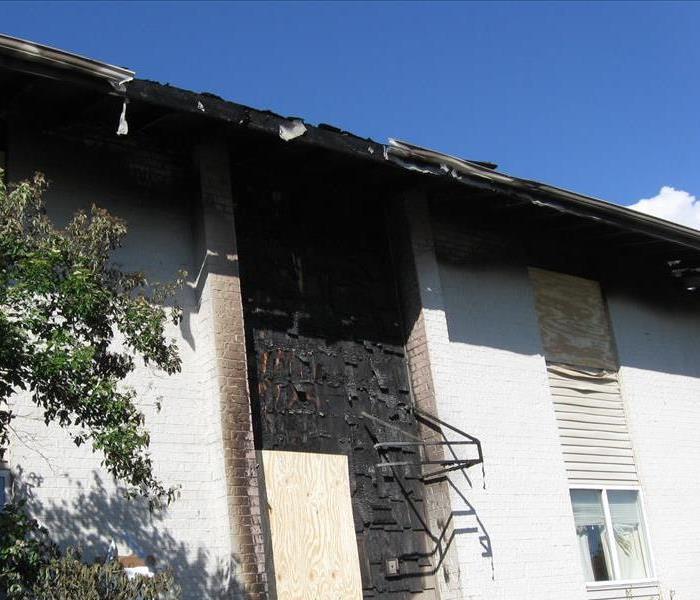 Boarded up apartment after a fire.
Boarded up apartment after a fire.
Why take the risk? Call a SERVPRO of Southwest Grand Rapids.
Whether after a fire, storm, or other structural disaster, boarding up damaged property is a burden that no one should ever have to go through—especially if it is your property that has been damaged.
Boarding up damaged property incorrectly could cause secondary damages such as moisture or animal intrusion, making the situation even worse. The process of boarding up after an unexpected damage can also be as dangerous as the damage itself.
SERVPRO of Southwest Grand Rapids can board up the damaged property and mitigate and remediate the original damage, providing you with peace of mind while helping make it
“Like it never even happened.” Contact us at 616-662-9700 for 24/7 emergency service.
When Storms or Floods hit Southwest Grand Rapids, SERVPRO is ready!
4/10/2017 (Permalink)
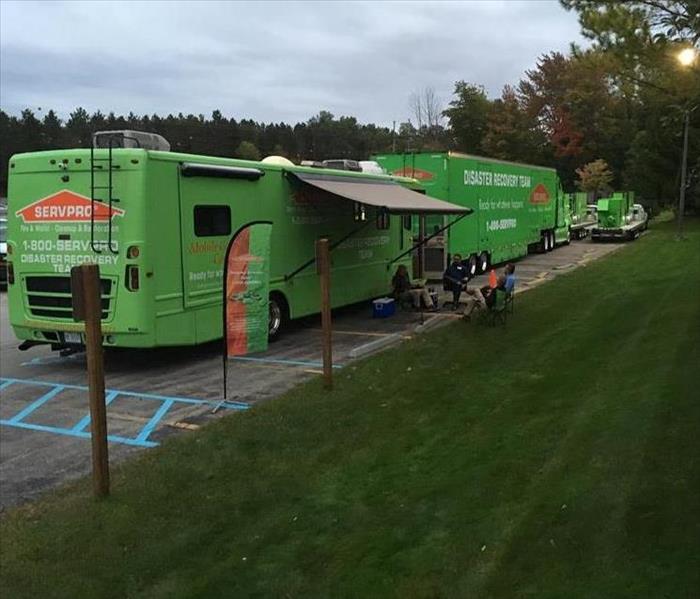 Our highly trained crews are ready to respond 24/7 to storm or flood damage in Southwest Grand Rapids.
Our highly trained crews are ready to respond 24/7 to storm or flood damage in Southwest Grand Rapids.
SERVPRO of Southwest Grand Rapids specializes in storm and flood damage restoration. Our crews are highly trained and we use specialized equipment to restore your property to its pre-storm condition.
Faster Response
Since we are locally owned and operated, we are able to respond quicker with the right resources, which is extremely important. A fast response lessens the damage, limits further damage, and reduces the restoration cost.
Resources to Handle Floods and Storms
When storms hit Southwest Grand Rapids, we can scale our resources to handle a large storm or flooding disaster. We can access equipment and personnel from a network of 1,650 Franchises across the country and elite Disaster Recovery Teams that are strategically located throughout the United States.
Have Storm or Flood Damage? Call Us Today 616-662-9700




 24/7 Emergency Service
24/7 Emergency Service



